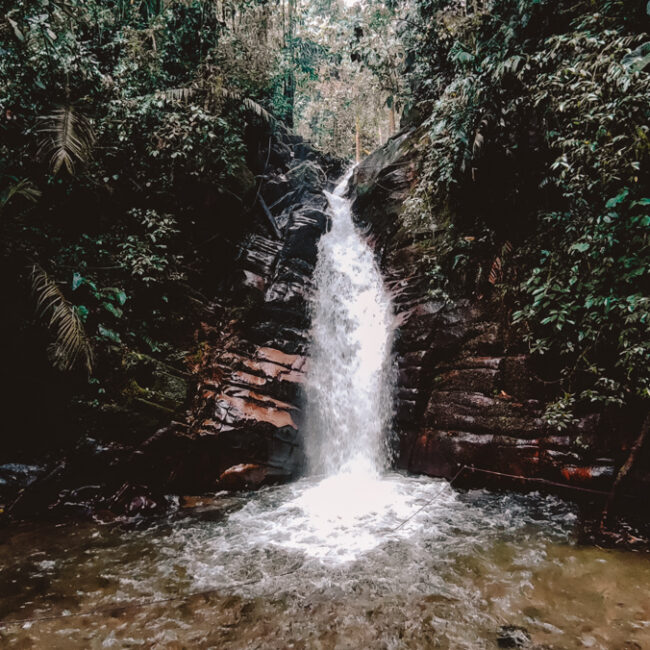

Thailand is a land of vibrant culture, stunning natural landscapes, and mouth-watering cuisine. As a vegan traveler, you may be wondering how to navigate the local food scene without compromising your principles. Fortunately, Thailand has a rich vegetarian and vegan cuisine tradition, and with a little insider knowledge, you can experience the best Thai food without sacrificing your ethics. In this guide, I will let you in on my experience traveling as a vegan in Thailand, various dishes that are suitable for plant-based foodies and more tips!

Khao Sok National Park, Thailand
Thailand is one of the most popular Southeast Asian countries known for its breathtaking natural landscapes, tropical forests, pristine beaches, and majestic mountains.
The country is also steeped in Buddhist tradition, with thousands of temples and monasteries scattered throughout its cities and countryside.
However, Thailand has also struggled with the problem of overtourism, with popular destinations like Bangkok and the Southern islands often overrun with tourists. This has put a strain on the environment and local communities, leading to issues like pollution and overcrowding.
Despite these challenges, Thailand remains a popular destination for travelers seeking adventure, culture, and spiritual enlightenment.
Thailand is still a great country, but, as a conscious traveler, you’ll need to stray off the beaten path if you want to find a place that is still relatively untouched by tourism.
→ PRO TIP: Traveling soon? check out my ultimate packing list for Thailand!
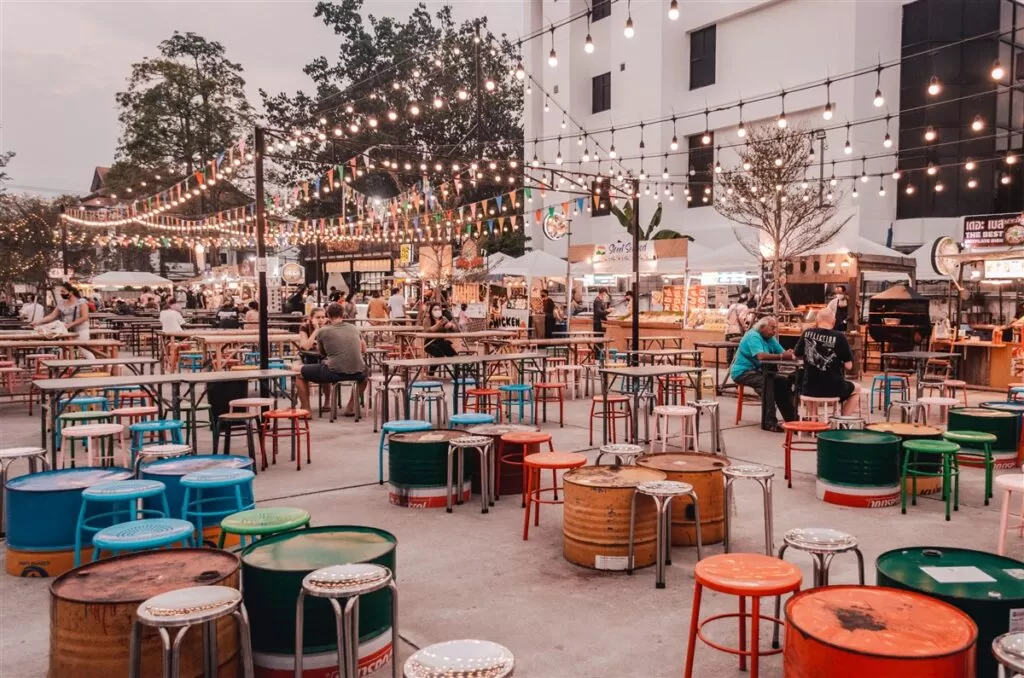
Food court at Chiang Mai Night Bazaar, Thailand
Thai food culture is known for its unique blend of sweet, sour, salty, and spicy flavors. Rice is a staple ingredient in most dishes, and coconut milk, lemongrass, and chili peppers are commonly used in curries and soups.
Some popular traditional dishes include Pad Thai, a stir-fried noodle dish with vegetables and peanuts, Mango sticky rice, a sweet (and 100% vegan!) dessert, and Massaman Curry, a mild curry made with coconut milk, potatoes, and peanuts.
Depending on where you’re traveling in Thailand, you will encounter typical regional dishes, like for example Mekong seaweed crackers in the northeast of the country, Khao Soi in the north, and distinct Burmese influences in the west.
No matter the location, Every plate that you will devour will be a flavorful dish that showcases the freshness of vegetables and the boldness of spices. Thai food culture celebrates the importance of balance in taste, texture, and nutrition, making it a diverse and exciting cuisine to explore.

Sukothai, Thailand
Thailand is known for its delicious food, and, in general, it is also a country that is quite vegan-friendly. The abundance of fresh fruits and vegetables makes it easy to find vegan options, and the use of coconut milk and tofu as substitutes for animal products is common in many traditional dishes.
Additionally, Buddhist culture encourages a vegetarian or vegan diet as a way to show compassion for all living beings.
However, it’s important to note that not all Thai dishes are vegan, and some can contain hidden ingredients like fish sauce or shrimp paste as a flavoring agent. Additionally, some street vendors may not understand the concept of veganism, so it’s important to communicate you preferences clearly and be aware of these hidden ingredients.
Despite these challenges, Thailand is a great destination for vegans looking to explore Asian cuisine.
Ordering vegan in Thailand can be a bit of a challenge, but it’s definitely doable with a little bit of knowledge and preparation. First, it’s important to learn some basic Thai phrases that explain your dietary requirements.
For example, “gin jay” means vegetarian, and “mai sai kai” means no eggs. Further down this blog post, you can find a list of vegan-friendly dishes so you’ll know what to look out for before arriving in Thailand.
When ordering at a restaurant, it’s important to communicate clearly with the server and ask about the ingredients in each dish. With a little bit of effort and preparation, ordering vegan in Thailand can be hassle-free and even a rewarding experience.
The best way to express your wishes if little English is spoken is to use Google Translate. When I traveled previously through Laos and Vietnam as a vegan I always used the same sentence and it worked well every time. This is what I used:
“I am a vegetarian. I don’t eat meat, fish, pork, or chicken. I also don’t eat milk, butter, eggs, cheese, fish sauce, oyster sauce, shrimp paste, and honey.”
Put it in Google Translate and you will be good to go! It will look like this:
“ฉันเป็นมังสวิรัติ ฉันไม่กินเนื้อ ปลา หมู หรือไก่ ฉันยังไม่กินนม เนย ไข่ ชีส น้ำปลา ซอสหอยนางรม กะปิ และน้ำผึ้ง”
Alternatively, you can also just screenshot this sentence here from the blog. That way, you don’t have to open Google Translate all the time!
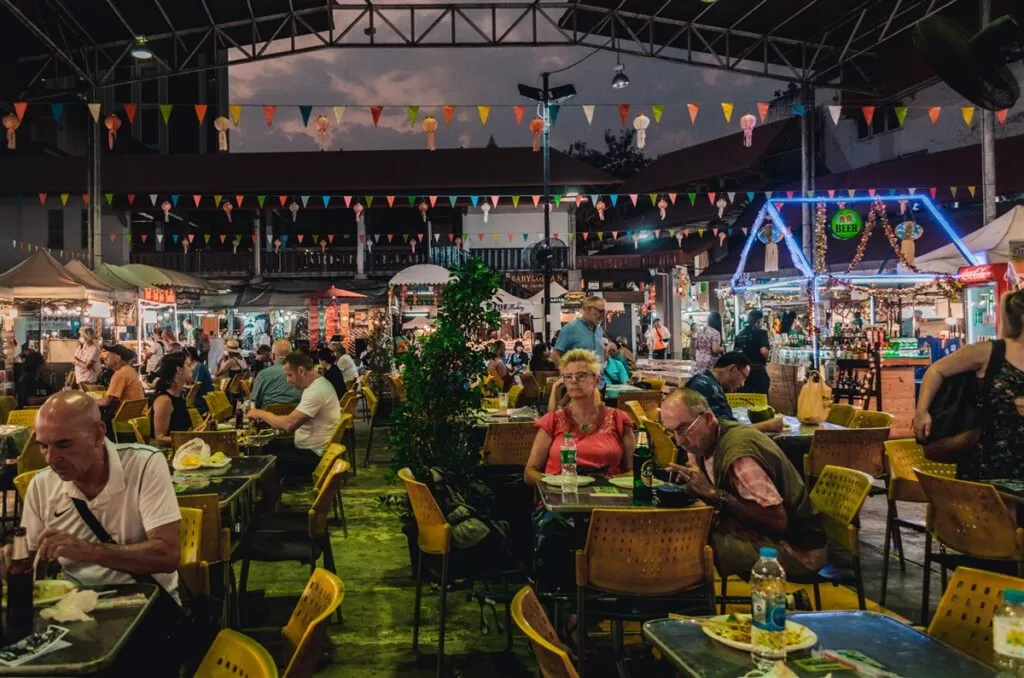
The cost of vegan food in Thailand can vary depending on where you eat and what you order. In general, street food and local markets tend to be quite affordable, with many vegan options, like Pad Thai, Mango sticky rice, and spring rolls available to people for a low price.
A plate of Pad Thai or stir-fried vegetables and rice from a street vendor may cost less than 50 baht (approximately $1.50 or €1.30).
On the other hand, some vegan restaurants and upscale cafes may charge higher prices for their dishes, especially in tourist areas. However, even at these places, the cost of vegan food is usually cheaper than meat-based dishes and will cost a fraction of what you would pay in Western countries.
Overall, vegan food in Thailand is quite affordable and accessible for travelers on a budget.
to help you prepare for your trip as a vegan to Thailand, I prepared a list of all the dishes I encountered on my trip that are vegan or can easily be veganised. It includes Thai dishes but also a set of Burmese vegan dishes that you can find easily at places by the Burmese border and the Andaman Sea for example on the island of Koh Phayam.
If you have any questions about these dishes, shoot me a message in the comments at the end of this post! Here we go.
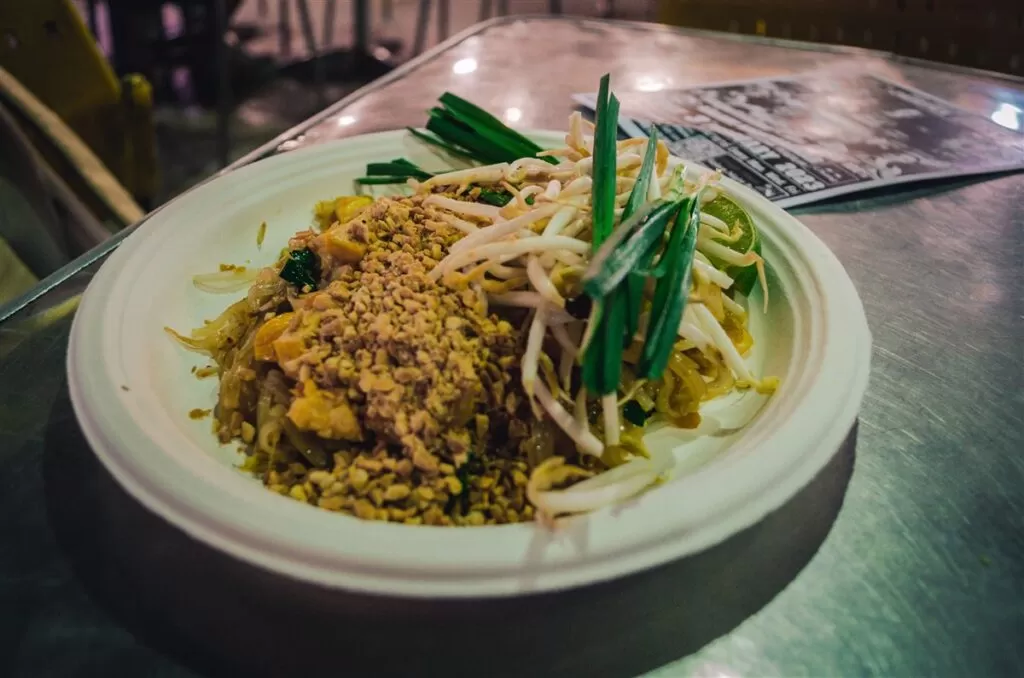
Vegan Pad Thai
Pad Thai is a stir-fried noodle dish that has its roots in Thailand. It typically includes rice noodles, vegetables, eggs, and tofu, and is flavored with a combination of sweet, sour, salty, and spicy ingredients. It is often garnished with crushed peanuts and fresh herbs and is a popular street food dish.
Pad Thai is however not vegan. It often includes shrimp paste and fish sauce so ask to exclude this while ordering.
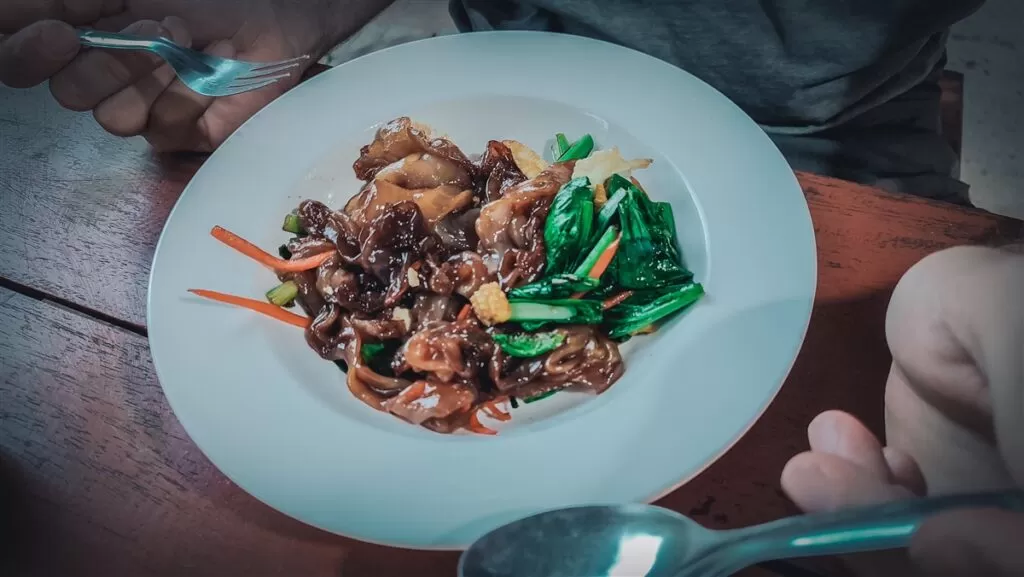
Pad See Ew
Pad See Ew is a Thai stir-fried noodle dish made with wide rice noodles, vegetables such as morning glory, soy sauce, and sometimes meat such as chicken or beef. The dish is typically seasoned with garlic, soy sauce, and a sweetener such as palm sugar.
It is a popular street food in Thailand and can be found in many local Thai restaurants around the country. If you see Pad See Ew on a menu it’s vegan if it doesn’t include meat or chicken. The sauce is vegan.
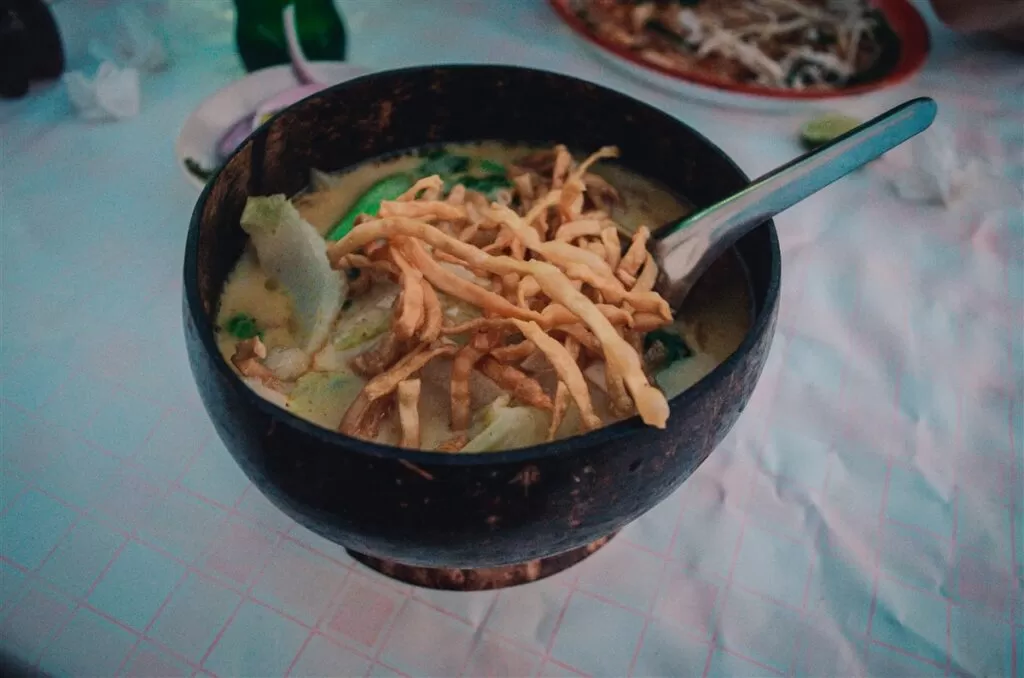
Khao Soi
Khao Soi is a popular Northern Thai dish that consists of a curry-based soup served with egg noodles, coconut milk, and meat such as chicken or beef.
The soup is seasoned with a variety of spices, including turmeric, chili, and coriander, which give it a distinctively rich and complex flavor. The dish is often served with a garnish of pickled mustard greens, onions, lime wedges, and crispy fried noodles on top.
Vegan versions can easily be found in restaurants in Chiang Mai. Alternatively, order a vegetable Khao Soi in a regular restaurant and ask them to replace the egg noodles with rice noodles.
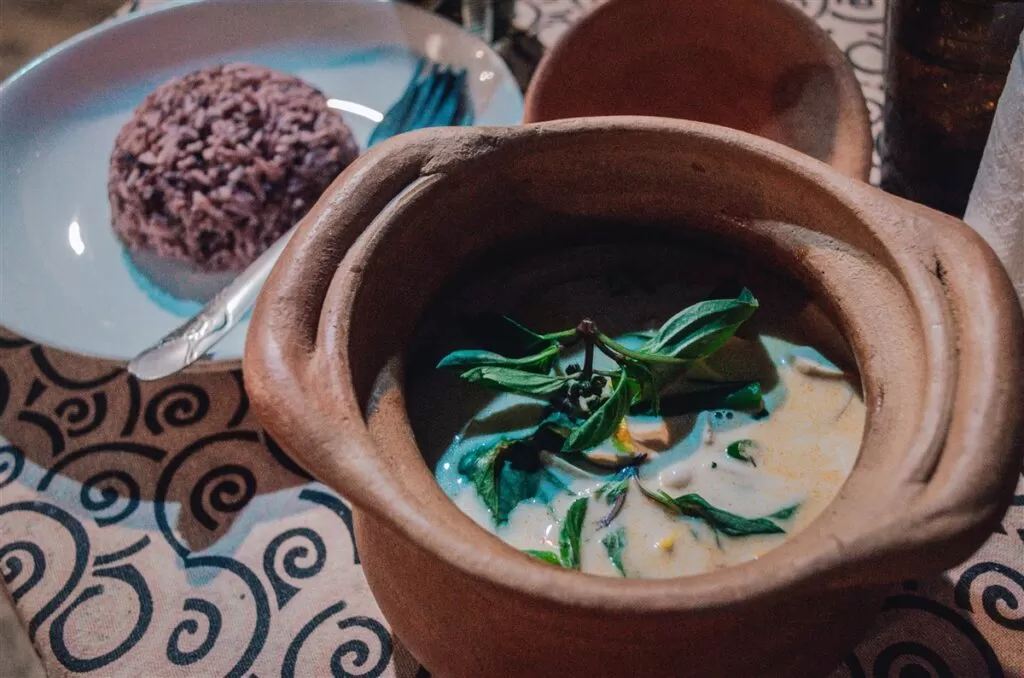
Vegan Tom Yum at The Vegan Society Restaurant in Chiang Mai
Tom Yum is a hot and sour Thai soup that is known for its spicy and tangy flavor. The soup is typically made with shrimp or chicken, lemongrass, kaffir lime leaves, galangal, fish sauce, chili peppers, and lime juice. The ingredients are simmered together to create a savory broth that is infused with the fragrant flavors of the herbs and spices.
Tom Yum is often served with a side of rice and is a popular dish in Thailand. Vegetarian and vegan versions of Tom Yum can be made easily by using vegetable broth and omitting the fish sauce and the meat or seafood.
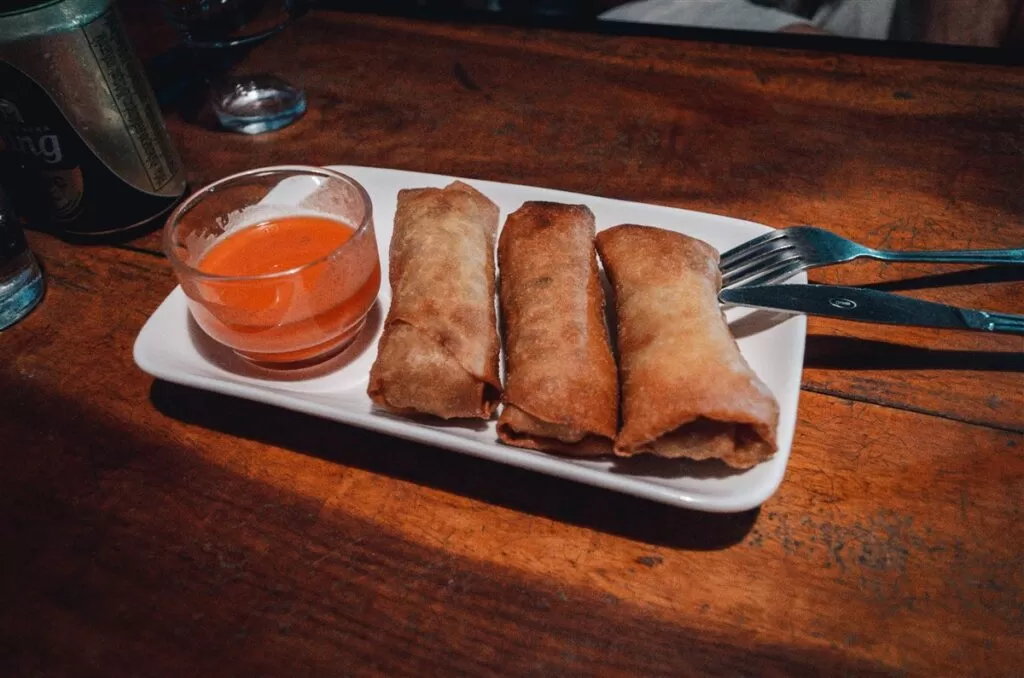
Fried spring rolls
Thai fried spring rolls, also known as “poh pia tod” or “tawd mun” in Thai, are a popular appetizer in Thai cuisine.
They are made by filling a thin wrapper with a mixture of vegetables such as cabbage, carrots, and bean sprouts, as well as meat such as chicken, pork, or shrimp, and then frying the rolls until they are crispy and golden brown. Thai spring rolls are typically served with a sweet-and-sour dipping sauce.
Most street food stalls in Thailand sell vegan versions, without meat, fish, and eggs. Inquire if the sauce contains fish sauce.
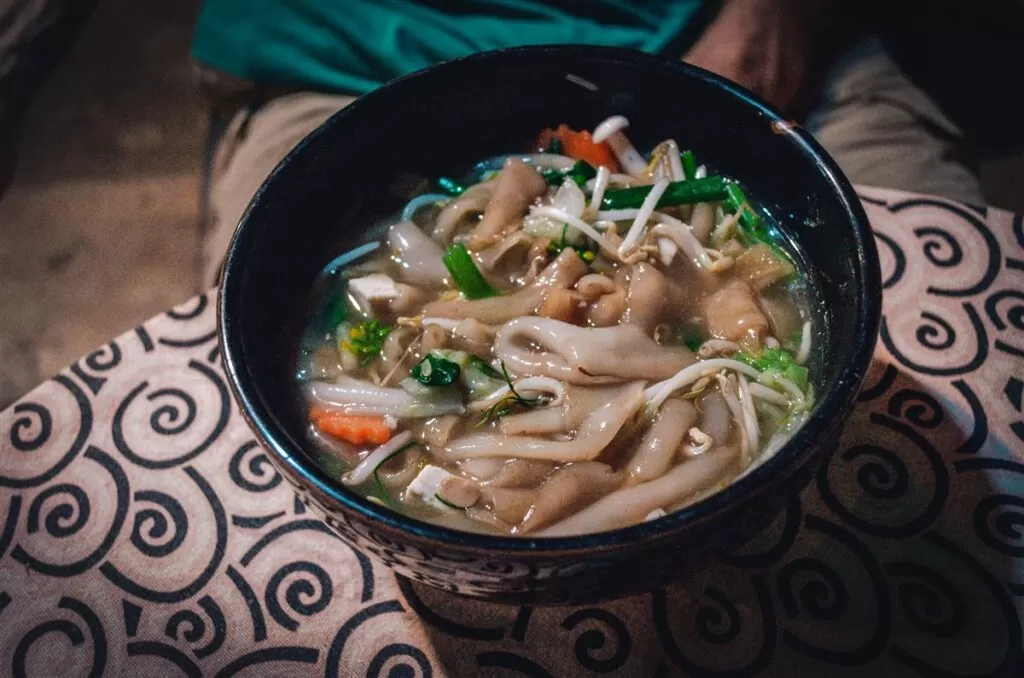
Vegan Lad Na
Lad Na is a Thai stir-fried noodle dish that is typically made with wide rice noodles, meat or seafood such as chicken, beef, or shrimp, and vegetables. The dish is traditionally flavored with a savory gravy made from soy sauce, oyster sauce, and cornstarch, which gives it a thick and glossy texture.
Lad Na is a popular street food dish in Thailand but it’s hard to find vegan versions at local markets or restaurants. However, vegetarian and vegan versions of Lad Na can be made by using vegetables or tofu instead of meat or seafood and are sold at vegan restaurants in Thailand.
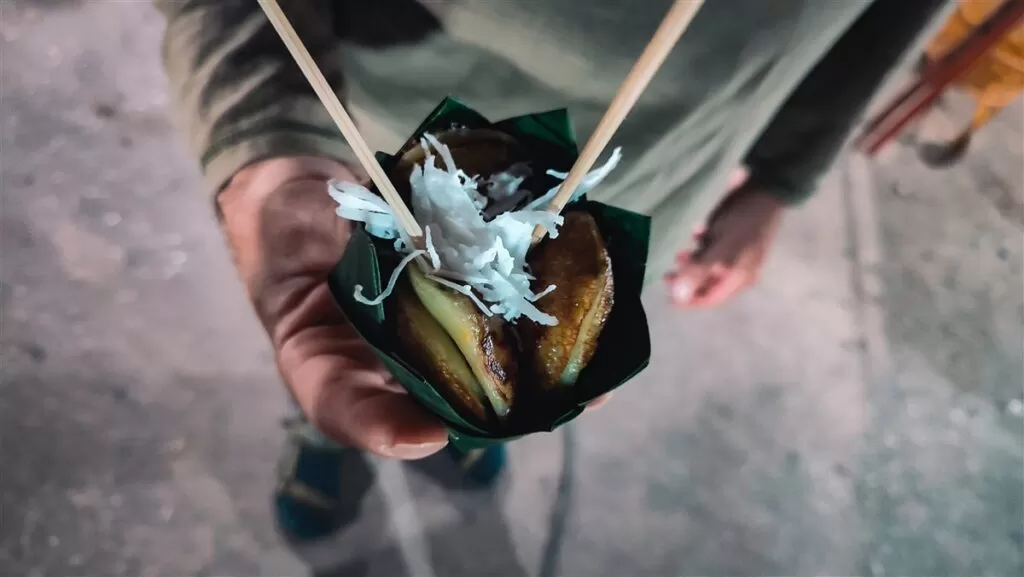
Kanom Krok
Kanom Krok is a traditional Thai dessert that consists of small, cup-shaped cakes made from a batter of rice flour, coconut milk, and sugar. The great thing about Kanom Krok is that it is originally vegan, so you don’t have to worry about hidden ingredients while ordering this!
The cakes are cooked in a special cast-iron pan with round indentations, which gives them their distinctive shape. The cakes have a crispy outer layer and a soft, chewy center, and can be flavored with a variety of ingredients such as scallions, corn, or taro. They are often garnished with a sprinkle of shredded coconut.
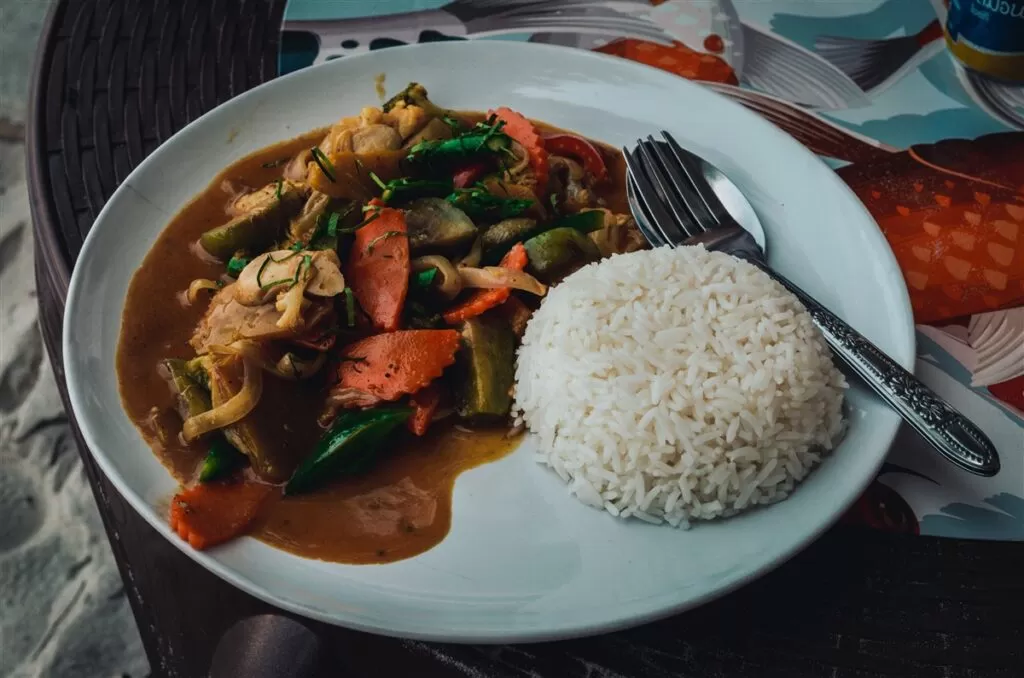
Panang Curry
Curry is a traditional Thai dish and you can find several types of them in the country. Green and red curries are somewhat spicy while a yellow curry is milder and a Panang Curry is a great combination of mild and creamy with a hint of spiciness.
You can find vegetable curries on the menu of most Thai restaurants. Sometimes they also include tofu or are pumpkin-based.
Ordering curry is tricky in Thailand! The curry paste is often prepared beforehand and can contain shrimp paste or fish sauce. It’s important to inquire about this when ordering. Dishes in Thailand are mostly cooked from scratch so chances are big that they can veganize the curry.
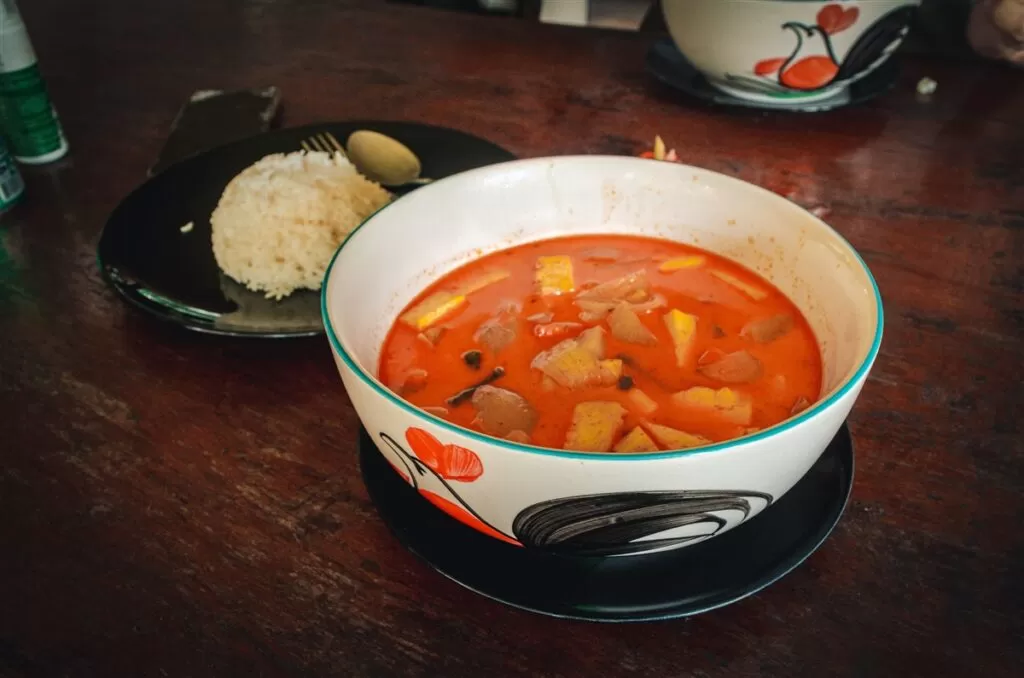
Massaman Curry
Massaman Curry, also known as “Gaeng Massaman” in Thai, is another type of Thai curry that has a mild and slightly sweet flavor. I wanted to mention this curry separately from the others because it contains typical fixed ingredients like potato and peanuts.
The curry is traditionally made with a blend of spices such as cinnamon, cardamom, cloves, and nutmeg, which give it a unique flavor profile. The curry is typically made with meat, such as beef or chicken but you can find vegetable-only versions throughout the country.
The sauce is made with coconut milk, tamarind paste, and palm sugar. Ask them to refrain from using fish sauce and if the curry paste contains shrimp paste.
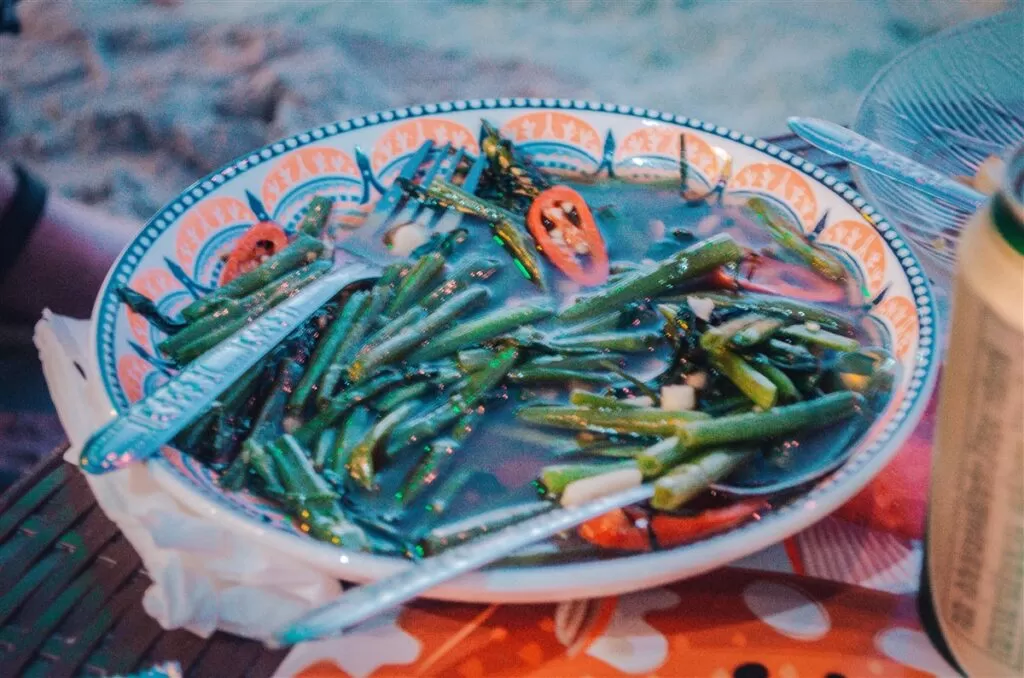
Fried Morning Glory
Fried Morning Glory, also known as “Pad Pak Boong” in Thai, is a popular vegetable dish in Thai cuisine. It is made by stir-frying fresh morning glory leaves and stems with garlic, chili peppers, and soybean sauce. The dish is typically served as a side dish or as a main course with rice (or ask for fries if you’re sick of rice!)
Fried Morning Glory can be vegan without asking but do inquire if they intend to use fish sauce or oyster sauce for the flavoring.
Thai Banana Fritters, also known as “Gluay Tod” in Thai, are a popular Thai dessert or snack made from ripe bananas that are coated in a batter made from rice flour, cornstarch, and coconut milk. The bananas are then deep-fried until golden brown and crispy on the outside, while still soft and sweet on the inside.
Generally, they are vegan, but you can always ask if they used eggs in the batter, just to be sure!

Mango sticky rice
Thai Sticky Rice with Mango, also known as “Khao Niew Ma Muang” in Thai, is a popular Thai dessert made from glutinous rice, fresh mango, and coconut milk. The glutinous rice is cooked until sticky and then mixed with a coconut milk mixture that has been sweetened with sugar and salt. The mixture is then served with slices of fresh mango on top.
Mango sticky rice is traditional vegan Thai food and I especially loved to have it for breakfast!
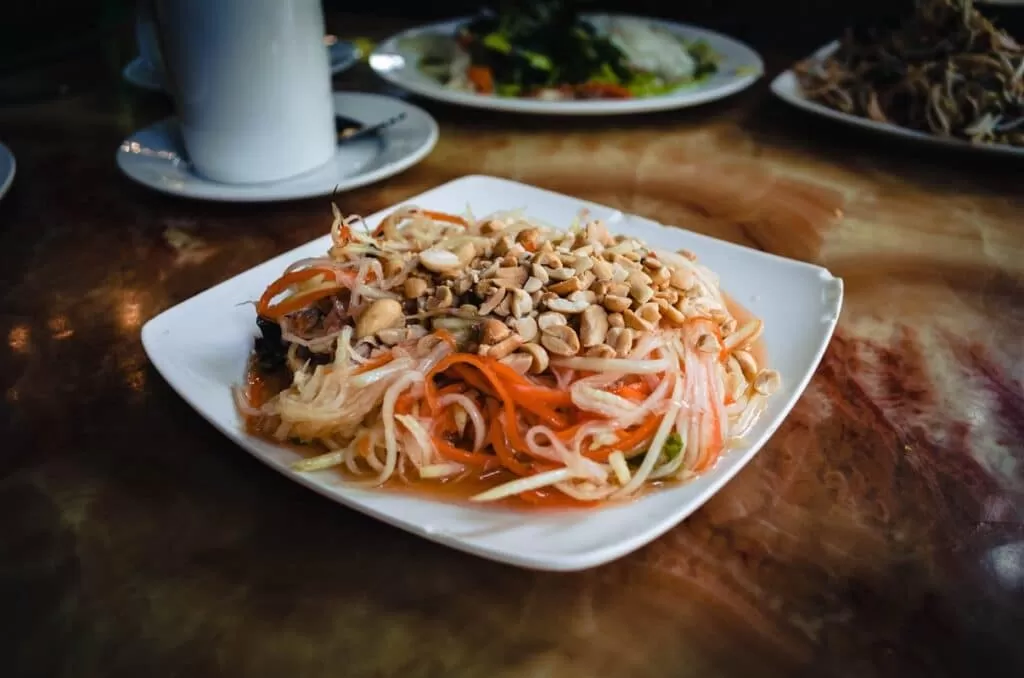
Papaya Salad
Thai Green Papaya Salad, also known as “Som Tum” in Thai, is a popular salad dish in Thai cuisine. It is made with shredded unripe papaya that is mixed with a spicy and tangy dressing made from lime juice, fish sauce, palm sugar, garlic, chili peppers, and tamarind juice. The salad may also contain other ingredients such as tomatoes, green beans, carrots, and peanuts.
For a vegan version, ask to exclude the fish sauce!
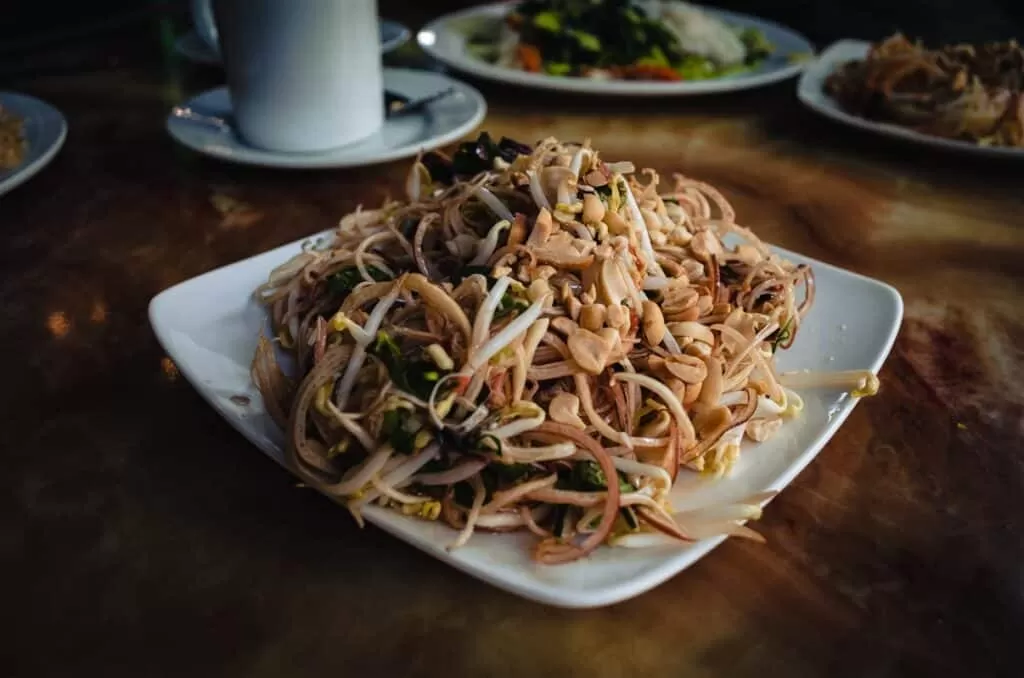
Banana blossom salad
Thai Banana Blossom Salad, also known as “Yum Hua Plee” in Thai, is a popular salad dish in Thai cuisine that is made from the large, tear-shaped flower of the banana plant.
The outer leaves of the banana blossom are removed and the yellow core is then thinly sliced and mixed with a spicy and tangy dressing made from lime juice, fish sauce, palm sugar, garlic, and chili peppers. The salad may also contain other ingredients such as red onions, roasted peanuts, and coriander leaves.
For a vegan version, again, ask to exclude or replace the fish sauce with a vegan alternative.
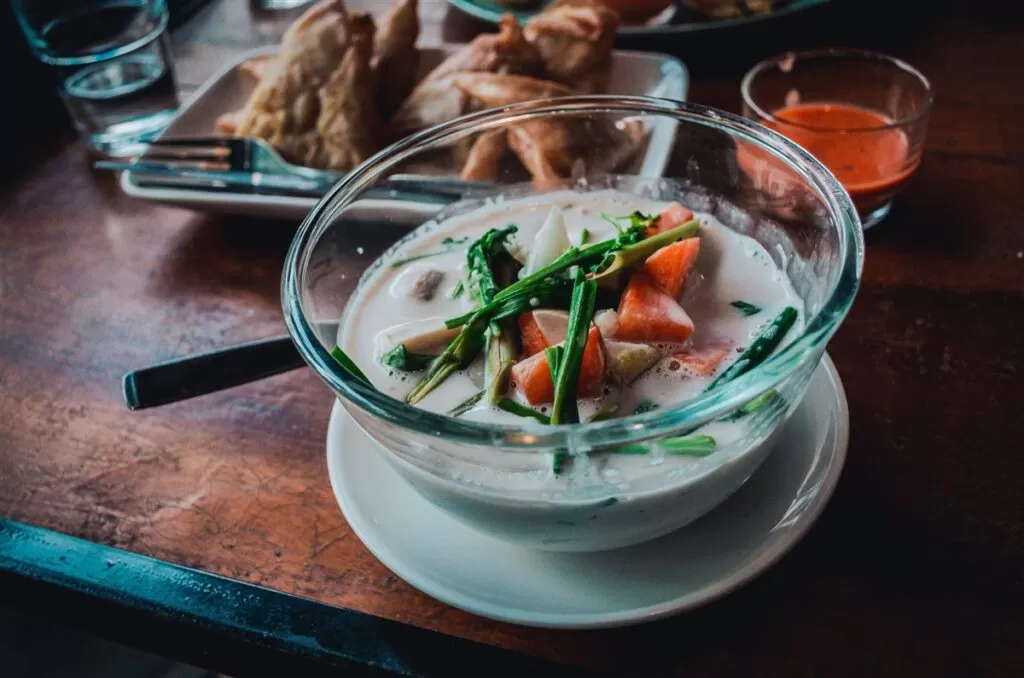
Thai coconut soup
Thai Coconut Soup, also known as “Tom Kha Gai,” is a popular Thai soup made with coconut milk, chicken (or sometimes shrimp), lemongrass, galangal (a type of ginger), lime leaves, and chili peppers.
The soup has a creamy and slightly sweet flavor from the coconut milk, which is balanced with the sour and tangy notes from the lime leaves and lemongrass. The ginger adds a subtle spicy and fragrant taste to the soup.
Vegetable versions with tofu are found in many restaurants. The soup sometimes contains fish sauce so you’ll need to enquire about that.
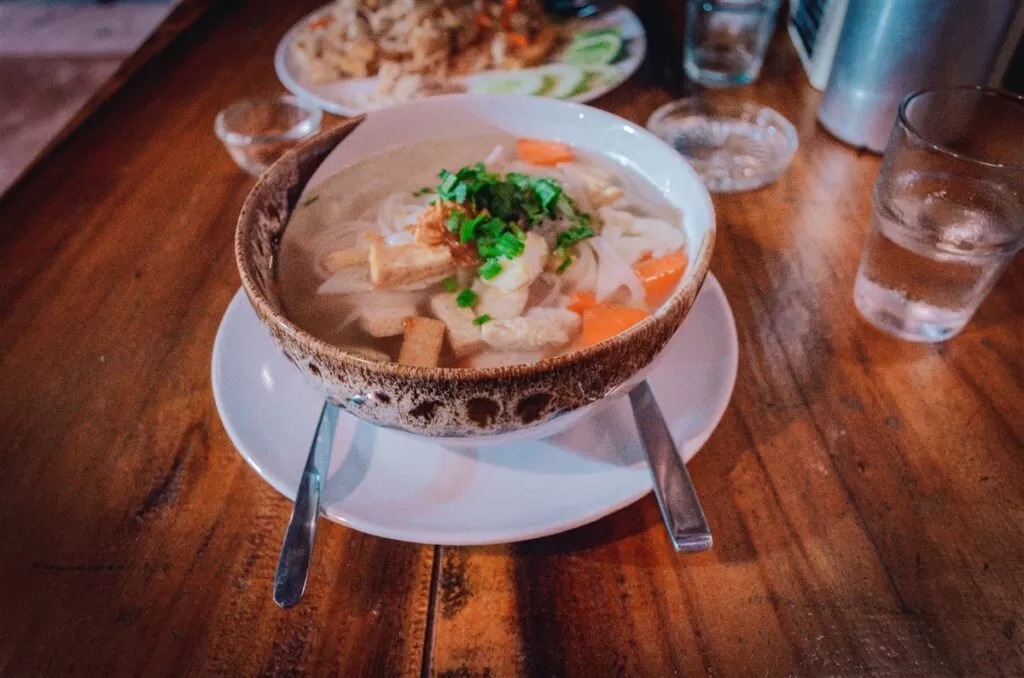
Thai Noodle Soup with tofu
Thai Noodle Soup, also known as “Guay Tiew” in Thai, is a popular and comforting soup dish in Thai cuisine. The soup is typically made with rice noodles that are cooked in a flavorful broth made with meat (usually pork or beef), chicken, or vegetables, along with herbs and spices such as garlic, ginger, coriander, and chili peppers.
Thai Noodle Soup resembles Vietnamese Pho and you can find vegan versions easily at Thai restaurants. It’s a bit harder to find it at food stalls since the broth is often prepared beforehand and will contain meat or chicken.
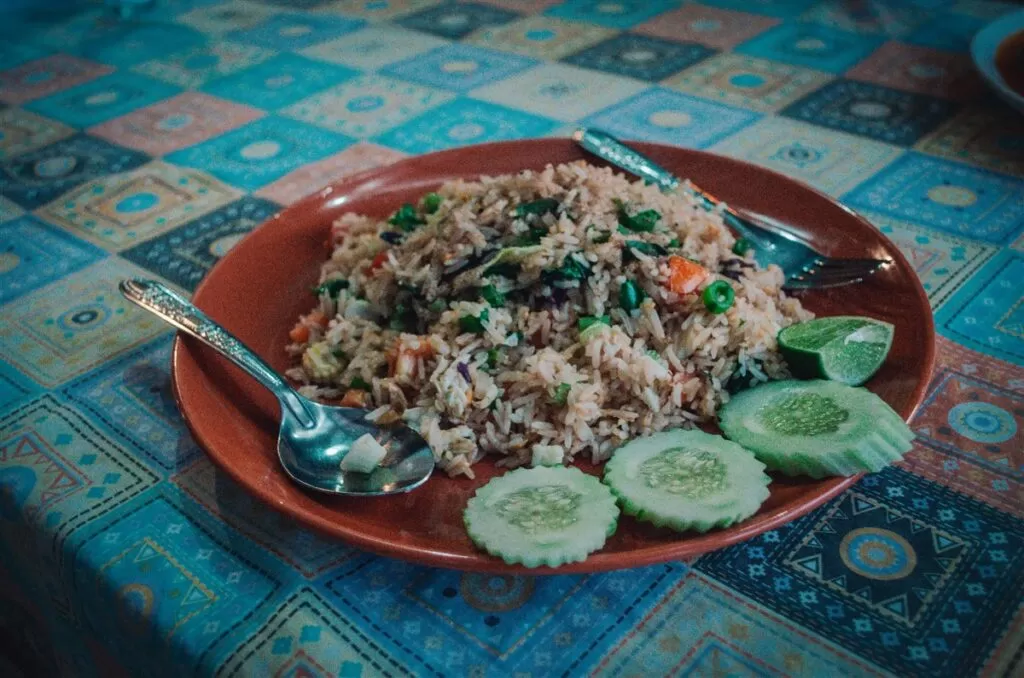
Thai fried rice
Thai Fried Rice, also known as “Khao Pad” in Thai, is a popular rice dish in Thai cuisine and you can find it all over Southeast Asia under a variety of names like nasi goreng (Indonesia) or Com Chien (Vietnam).
It is a simple dish made by stir-frying cooked rice with eggs, vegetables (such as peas, carrots, and onions), and usually a protein source such as chicken, shrimp, or tofu.
Fried rice with vegetables and tofu is a staple dish for vegans in Thailand. The dish is seasoned with soy sauce and herbs but can also include fish sauce or oyster sauce so inquire about this before ordering!
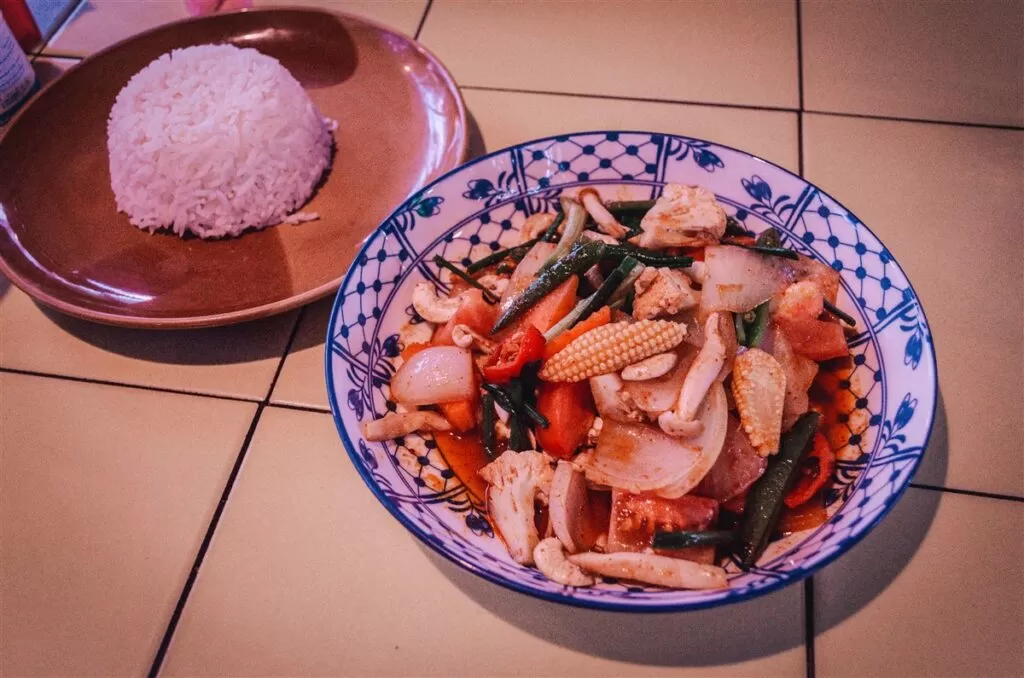
Fried cashew nuts with vegetables
Thai fried cashew nuts with vegetables is a popular Thai dish that combines the crunchy texture of cashew nuts with a stir-fried mix of vegetables. The dish typically includes cashew nuts, carrots, bell peppers, onions, and often mushrooms, broccoli, and baby corn. It is often served as a side dish or as a main course with steamed rice.
The sauce generally contains chili, garlic, and soy sauce but it’s possible they add oyster sauce or fish sauce so it’s smart to ask about this when you order.
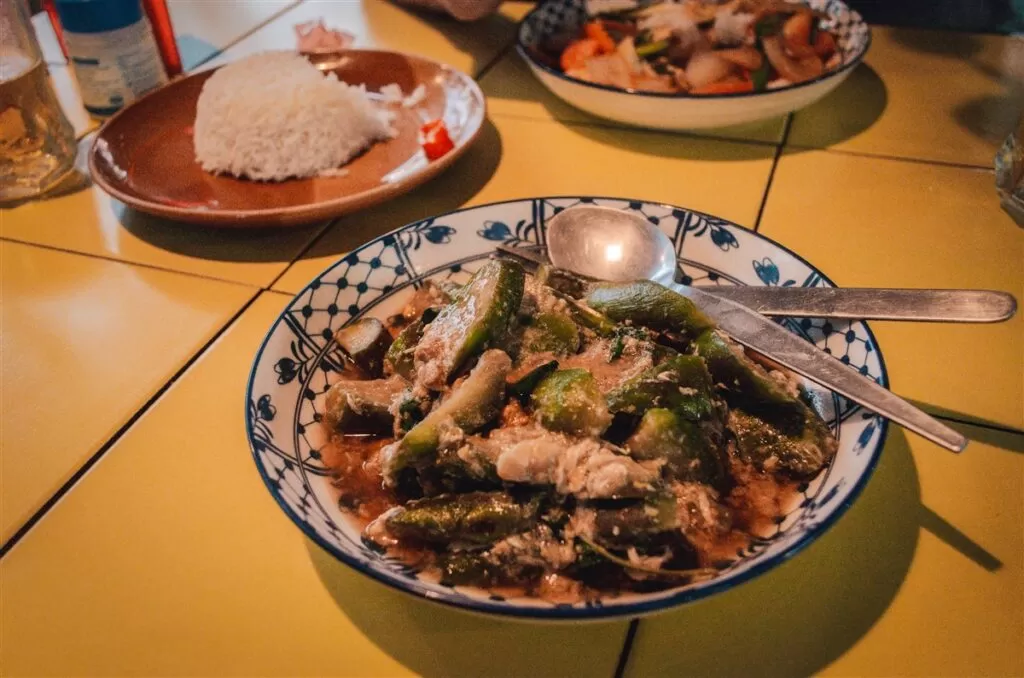
Fried eggplant
Thai fried eggplant is a dish that features eggplant that has been cut into bite-sized pieces and fried until crispy on the outside and tender on the inside. The dish typically includes a mix of vegetables and herbs, such as garlic, chili, onions, bell peppers, and basil, which are stir-fried with the eggplant to create a flavorful and aromatic dish.
Note that Thai eggplant is green and differs in taste and color from the purple eggplant you are probably familiar with. Inquire about the ingredients of the sauce!
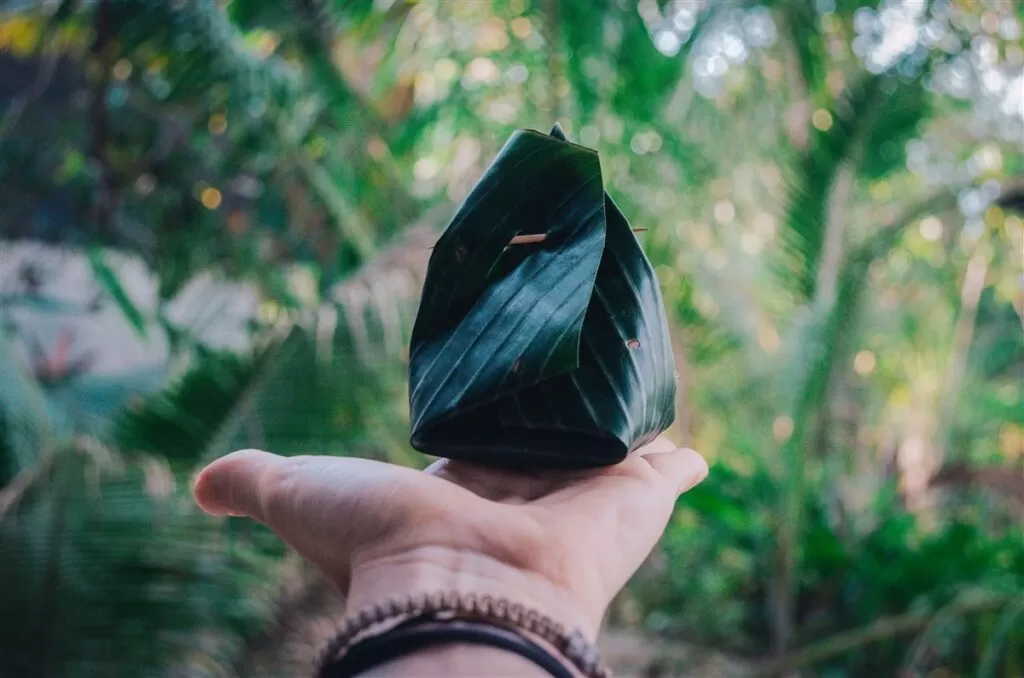
Sticky rice with coconut
Coconut sticky rice is a sweet and creamy dessert dish that is popular in many Southeast Asian countries, including Thailand. It is made by cooking glutinous rice with coconut milk, sugar, and salt until the rice grains are soft, sticky, and infused with the rich coconut flavor.
It’s the same base as they use to make Mango Sticky Rice although I found the rice in these banana leaf wrappers a bit less moist. It’s great to have for breakfast together with some fresh dragonfruit or banana.
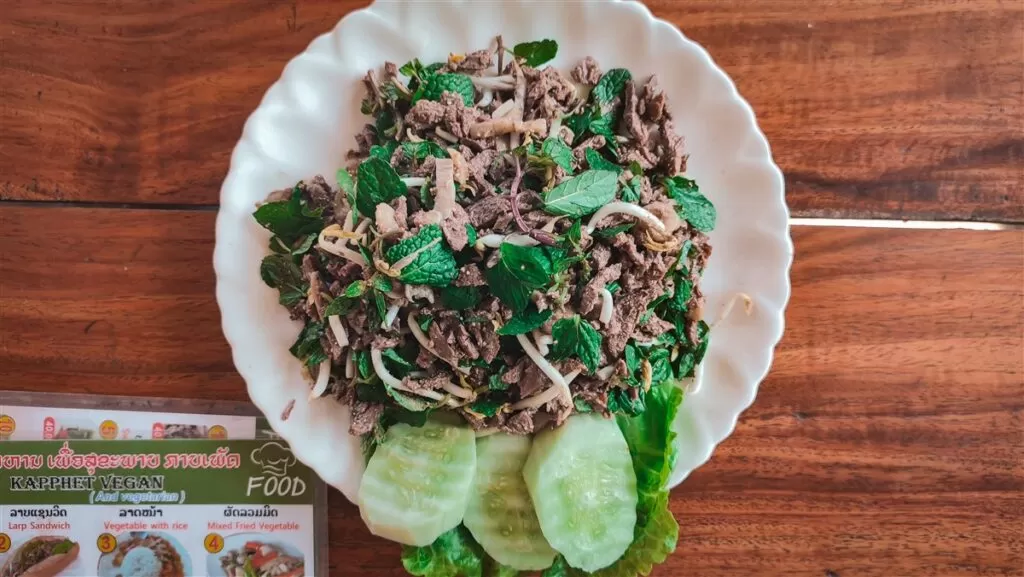
Laab
Laab, also known as larb, is a traditional dish from Laos that has become popular in Thai cuisine as well. It is a type of salad that is typically made with ground meat (usually chicken, pork, or beef), mixed with herbs, spices and lime juice.
You can find Laab in the North and northeastern part of Thailand near the border with Laos. Vegan versions are not that hard to find and are made with tofu, mushrooms, or another vegan protein. The seasoning can contain fish sauce so inquire about that when ordering.
Mekong seaweed crackers are a type of crispy snack that is popular in Thailand and other parts of Southeast Asia. The seaweed used in Mekong seaweed crackers is typically sourced from the Mekong River, which runs through several Southeast Asian countries, including Thailand.
Seaweed is known for its natural umami flavor and is a good source of nutrients such as iodine, iron, and calcium.
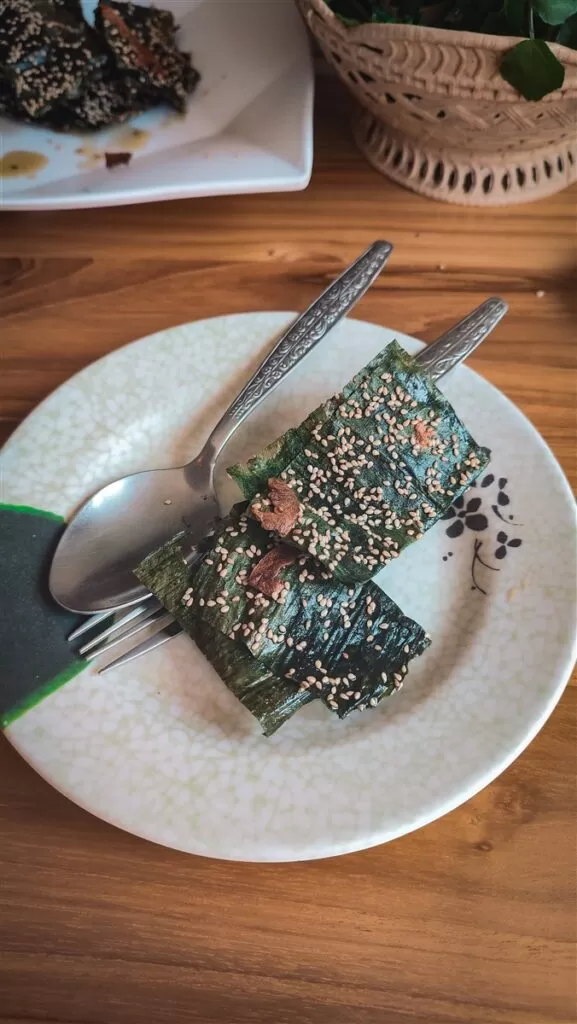
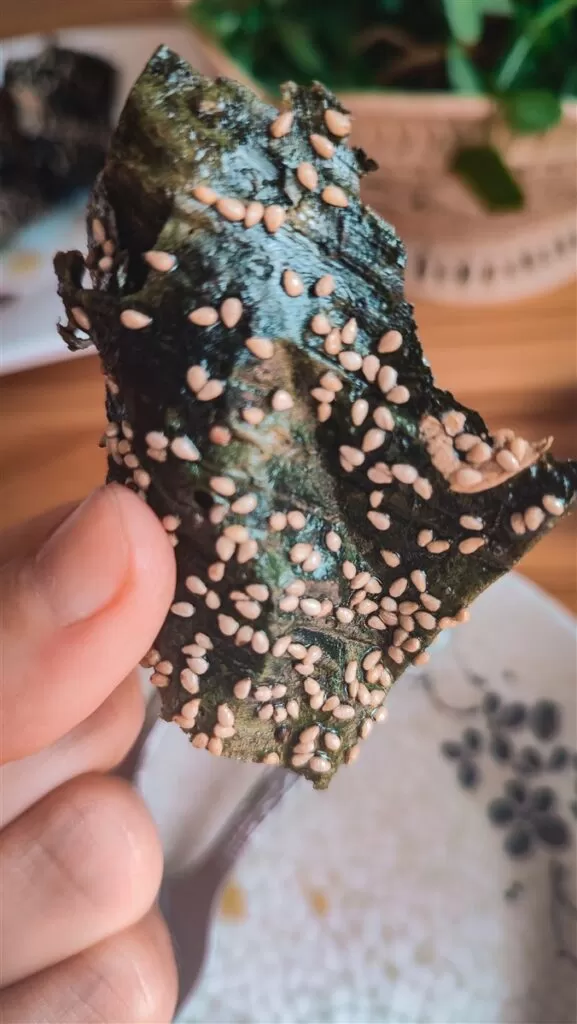
Mekong seaweed crackers
I’m not sure about how the seaweed papers are prepared but it seems like they are dried after being topped with sesame seeds, garlic, and sometimes chili flakes. After that, they are fried in oil.
Mekong seaweed crackers are a tasty and crunchy alternative to potato chips! You can find them in areas near de Mekong and the border with Laos.
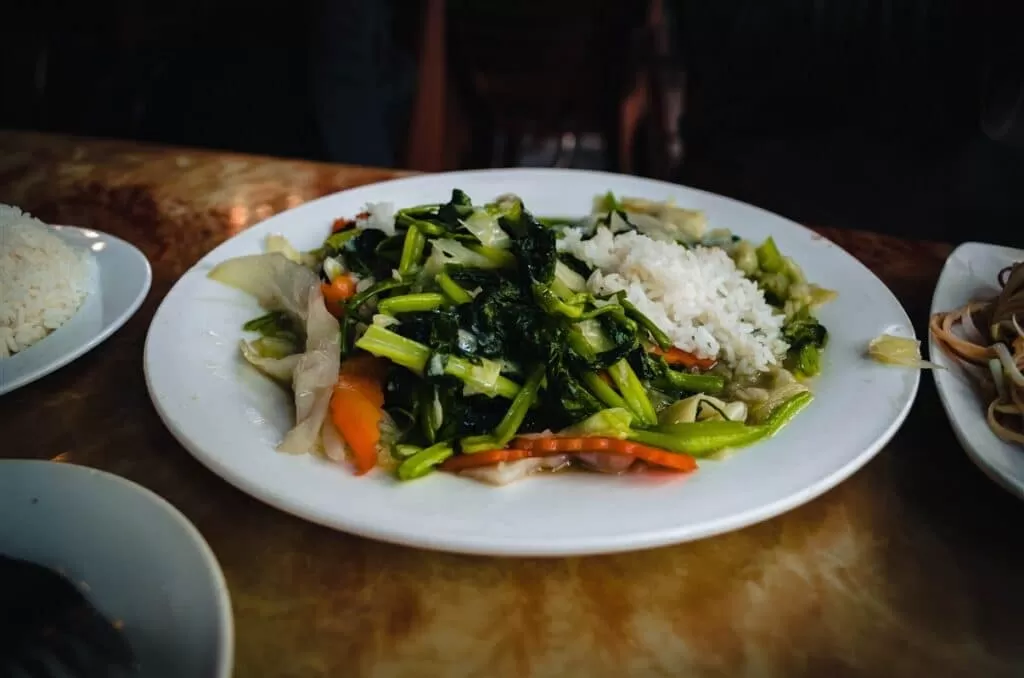
Stir-fried vegetables
Thai fried vegetables are a popular Thai dish that consists of a stir-fried mix of vegetables that are typically quickly cooked in a wok with garlic, chili, and a sauce made from soy sauce or oyster sauce.
It often includes morning glory and carrots and it’s served with rice. Ask them to refrain from using oyster sauce or fish sauce while ordering.
It is possible to find Burmese food in Thailand, particularly in areas of the country that are located near the border with Myanmar (Burma). In fact, there are many Burmese migrants and expatriates living in Thailand who have brought with them their traditional cuisine and cooking techniques.
I particularly enjoyed a lot of vegan Burmese food on Koh Phayam, an island in the Andaman Sea near the border with Myanmar. I also wanted to list these foods so you know what to expect when traveling near the Burmese border. Also, a lot of these dishes are originally vegan so you don’t have to worry about hidden non-vegan ingredients!
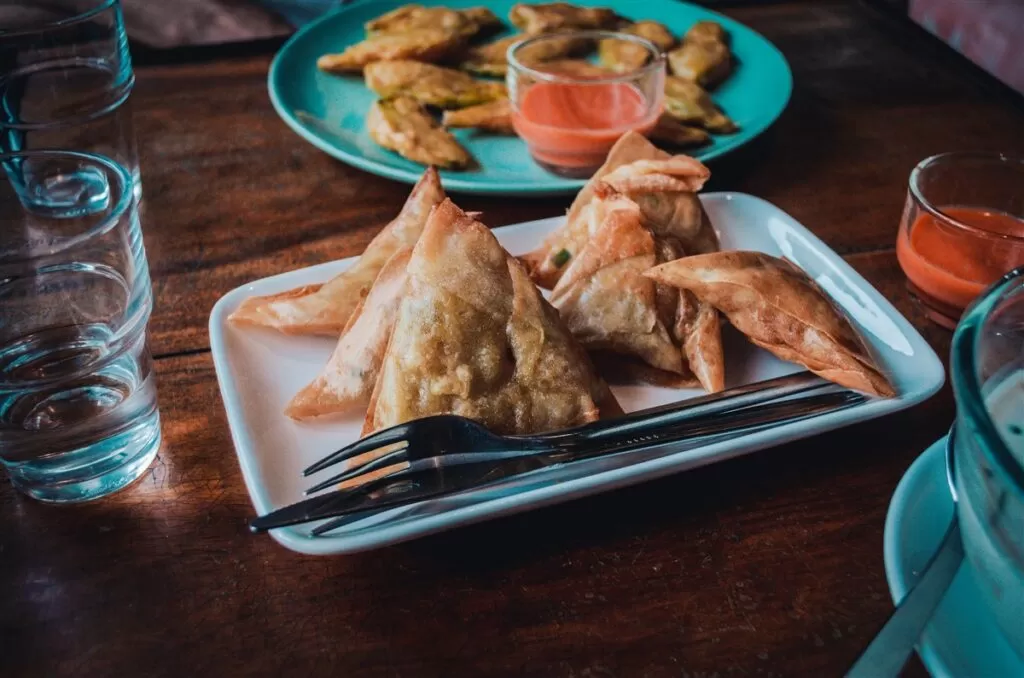
Burmese samosa
Burmese golden triangle samosas, are a popular snack in Myanmar (Burma) and neighboring countries, including Thailand. They are similar to Indian samosas but with some unique Burmese flavors and ingredients.
The vegan Burmese samosas I tried were made with a filling of potatoes, onions, and various spices such as cumin, coriander, and turmeric. It was served with a sweet but tangy sauce that included tamarind and garlic.
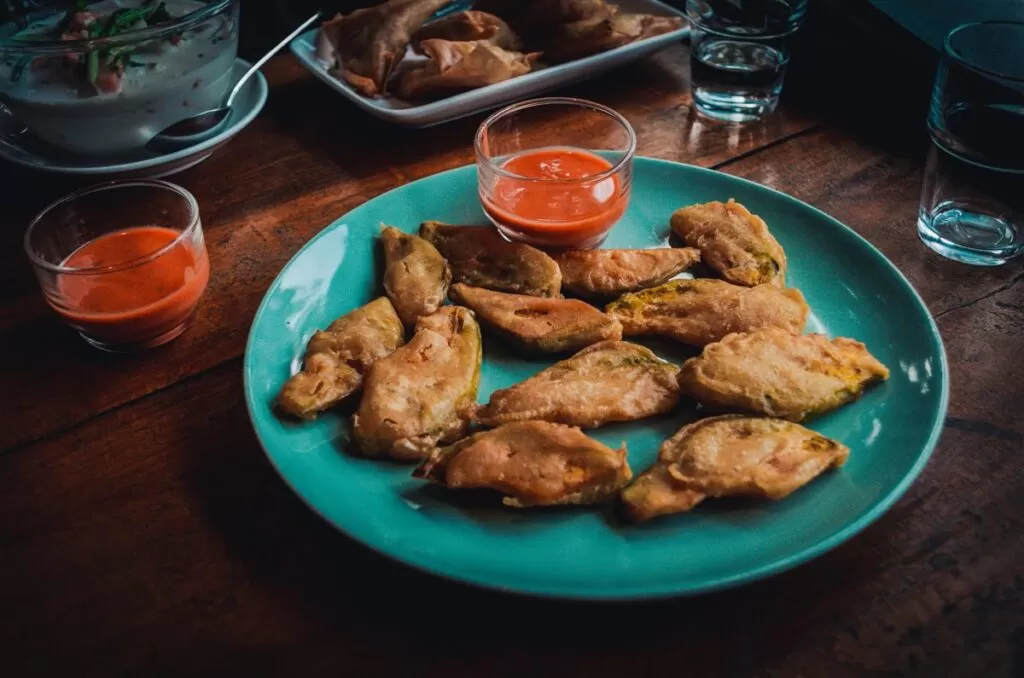
Pumpkin tempura
Burmese pumpkin tempura is a Burmese snack that is made by coating thin slices of pumpkin with a batter made from rice flour, turmeric, and water, and then deep-frying them until they are crispy and golden brown. This dish was served with the same dipping sauce made from tamarind, garlic, and chili.
Fried vegetable tempura is a common dish in Myanmar and the south of Thailand. I didn’t happen to take a photo of it by accident but I came across it in places like Koh Phayam and Khao Sok. Vegetable tempura is completely vegan!
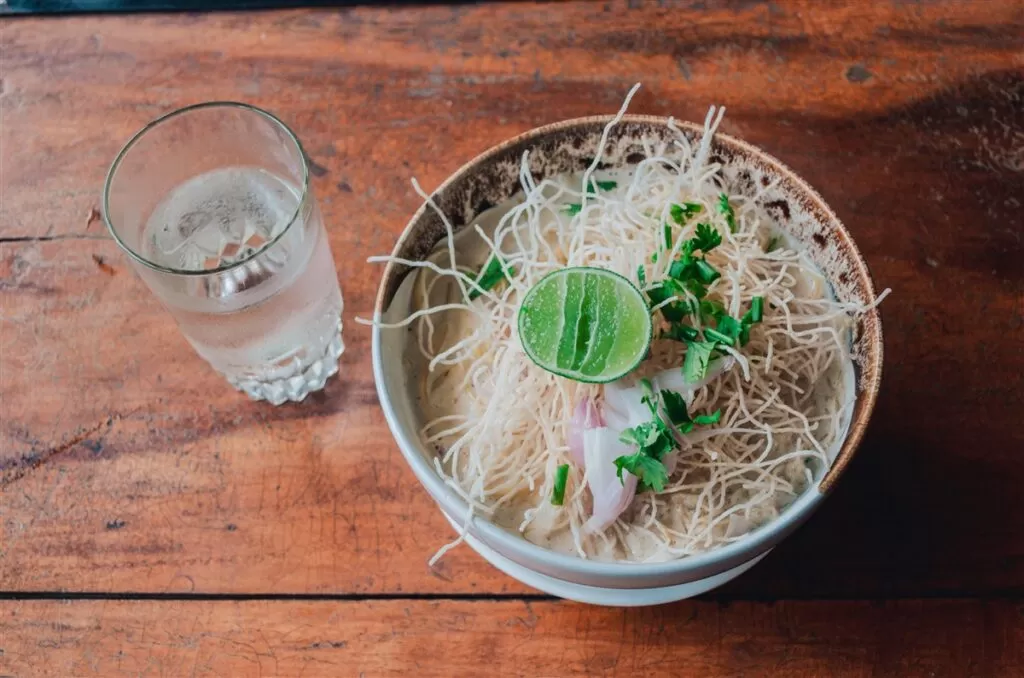
Ao-No Kaosuay
This Burmese vegan carbonara was by far the best dish I’ve tried while traveling through Southeast Asia. If you come across it, whether it’s in Thailand or Myanmar, you HAVE to try it. It’s so good.
It consists of a creamy coconut soup with noodles and fresh onion topped with fried rice noodles, coriander, and lime. The noodles are typically egg noodles but you can ask to replace them with rice noodles or yellow noodles. The Burmese name of this dish is “Ao-No Kaosuay”.
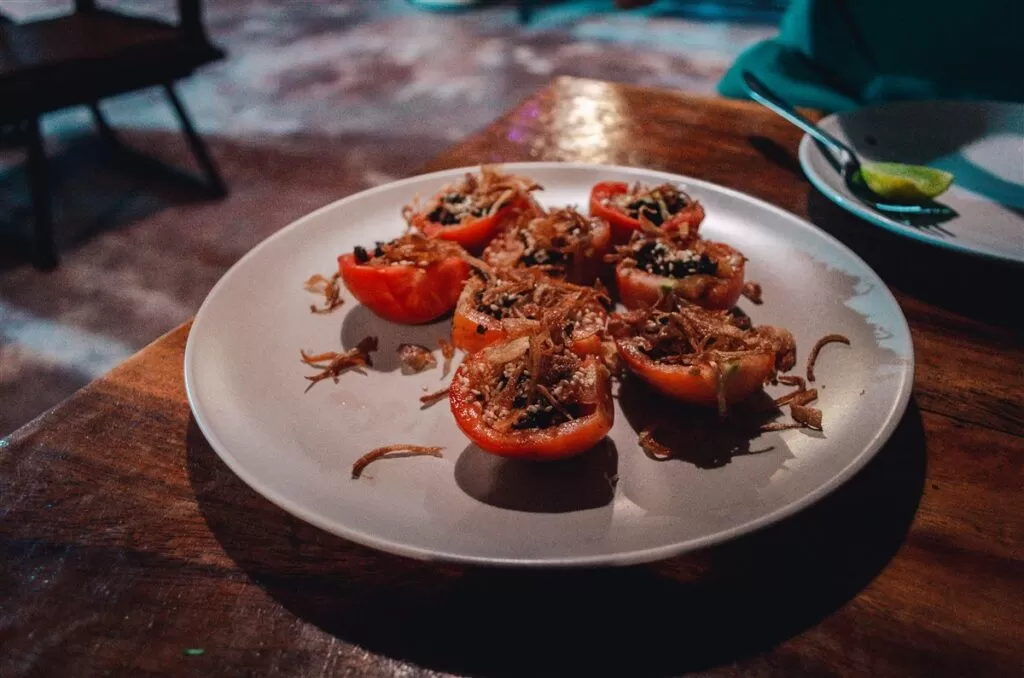
Kajanchietni Asahteh
These pickled tea leaf tomatoes were not my cup of tea but I wanted to include them because it’s completely vegan. For this dish, tomatoes are filled with pickled tea leaves, sesame seeds, and fried onion.
I know now that I’m not a fan of pickled tea leaves but don’t let that stop you from giving this dish a try! It goes by the Burmese name “Kajanchietni Asahteh”.
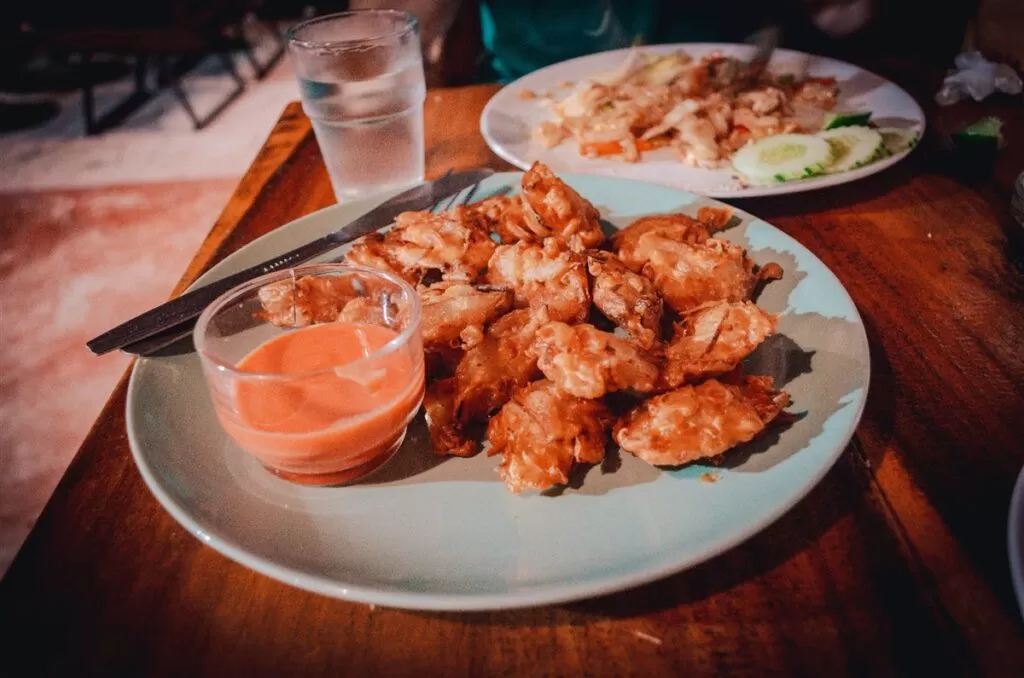
Burmese onion rings
As with the pumpkin tempura, these onion rings were coated with a batter of rice flour and water before deep-frying them until brown and crisp. It was served with the same tamarind and garlic pink sauce.
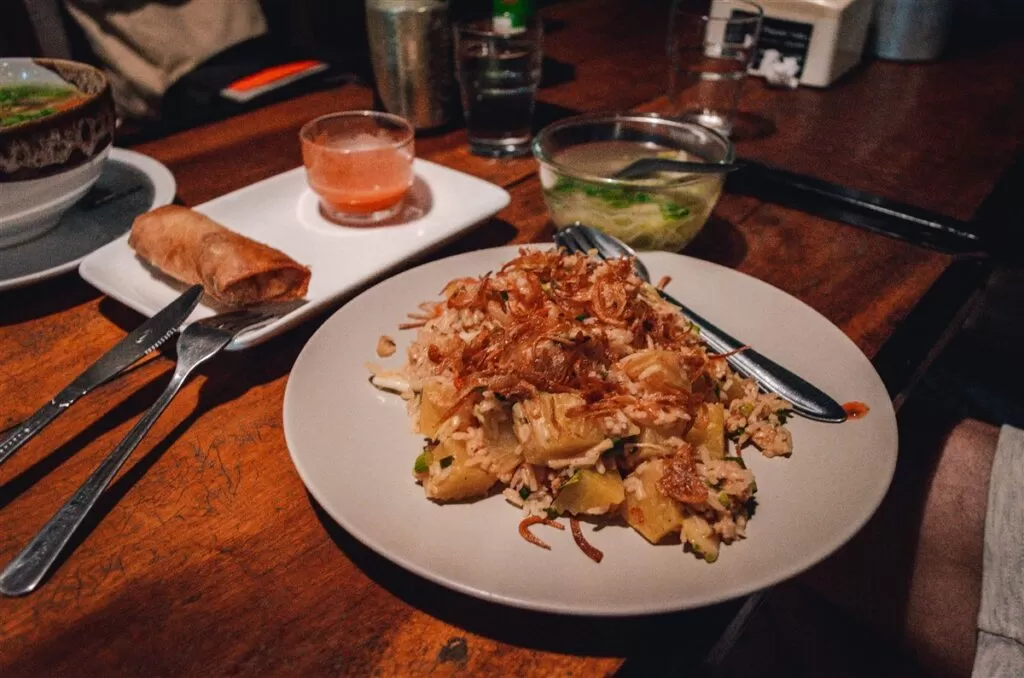
Tamin Toh
This vegan Burmese dish goes by the name of “Tamin Toh”. It was a very pleasant surprise to discover this dish. It didn’t really taste Asian at all and therefore was a nice change from the regular Southeast Asian flavors I got used to after traveling in the area for months.
Tamin Toh consists of rice, potatoes, and glass noodles with tomato and fried onions. It is served with a clear vegetable soup.
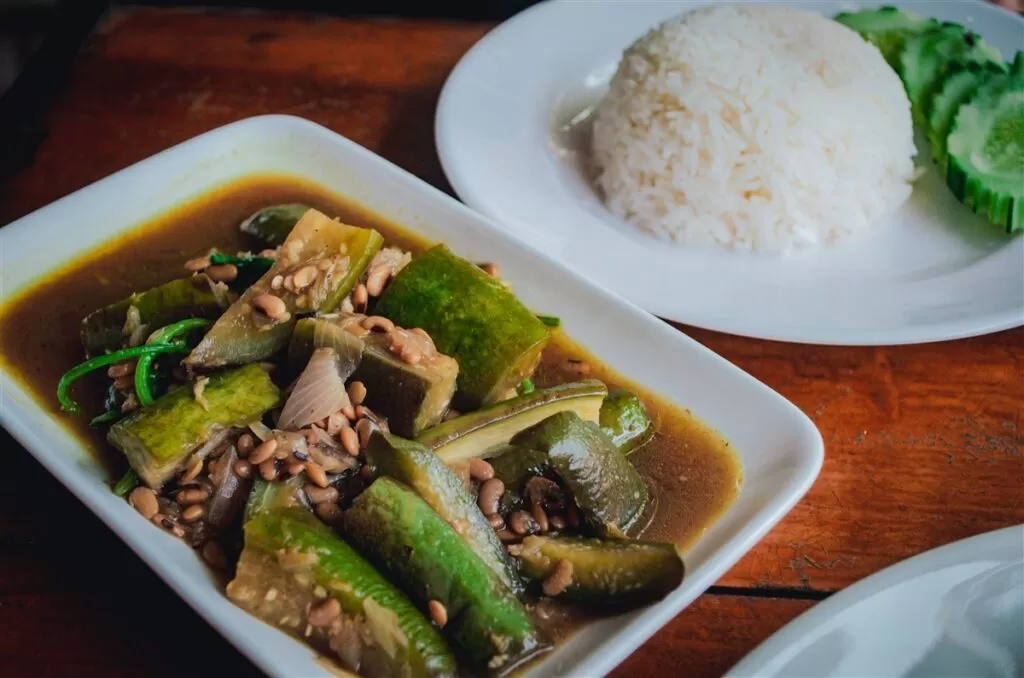
Kajanti Bow
These Burmese lentils with boiled Thai eggplant went by the name of Kajanti Bow. The owner said it was a typical Burmese dish and the key feature of this dish is the gravy which has a slightly sour taste.
It was served with rice and fresh cucumber and we were assured it was completely vegan.
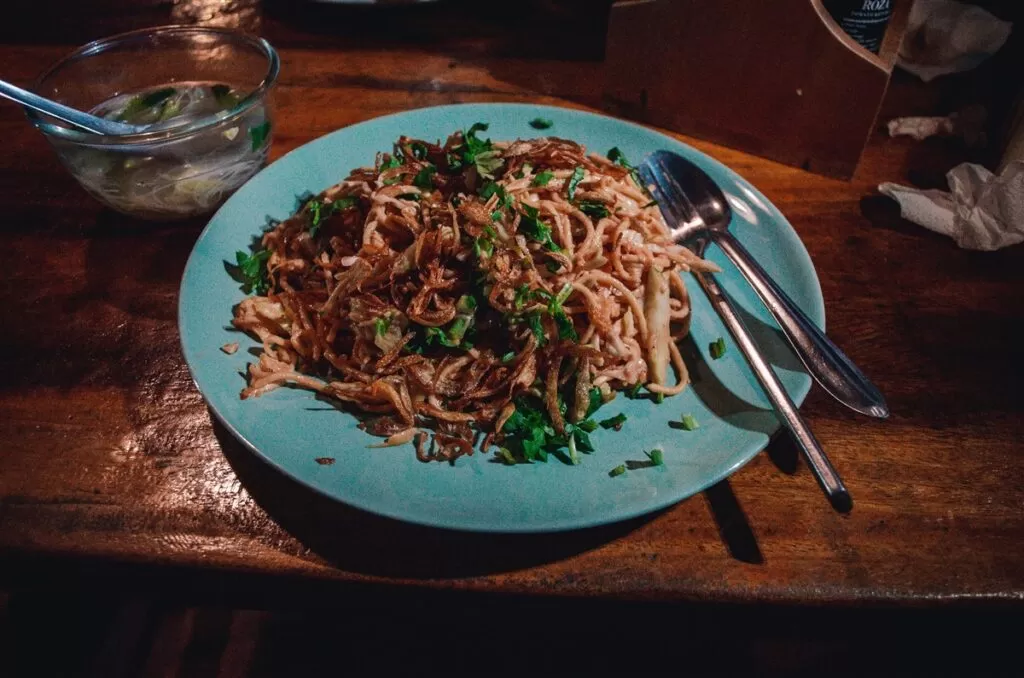
Khaosway Toh
Khaosway Toh is a vegan Burmese yellow rice noodle salad with vegetables served with a clear vegetable soup on the side. It is topped with fresh herbs and fried onions and is served cold.
It’s a great alternative for lunch if you have had it for a bit with Pad Thai or Ped See Ew.
it is possible to find vegan Western food in Thailand, particularly in larger cities and tourist areas. Many restaurants in Thailand, including those that serve Western cuisine, offer vegetarian and vegan options on their menus.
Some popular vegan Western dishes that can be found in Thailand include vegan burgers, pizzas, pasta dishes, and smoothie bowls.
smoothie bowls and oatmeal dishes are widely available in trendy and hip cafés in Bangkok, Chiang Mai, and many Thai islands that are geared toward Western tourists.
smoothie bowls generally have a coconut milk base and are topped with fresh tropical fruit like dragon fruit, papaya, and pineapple. The same goes for oatmeal.
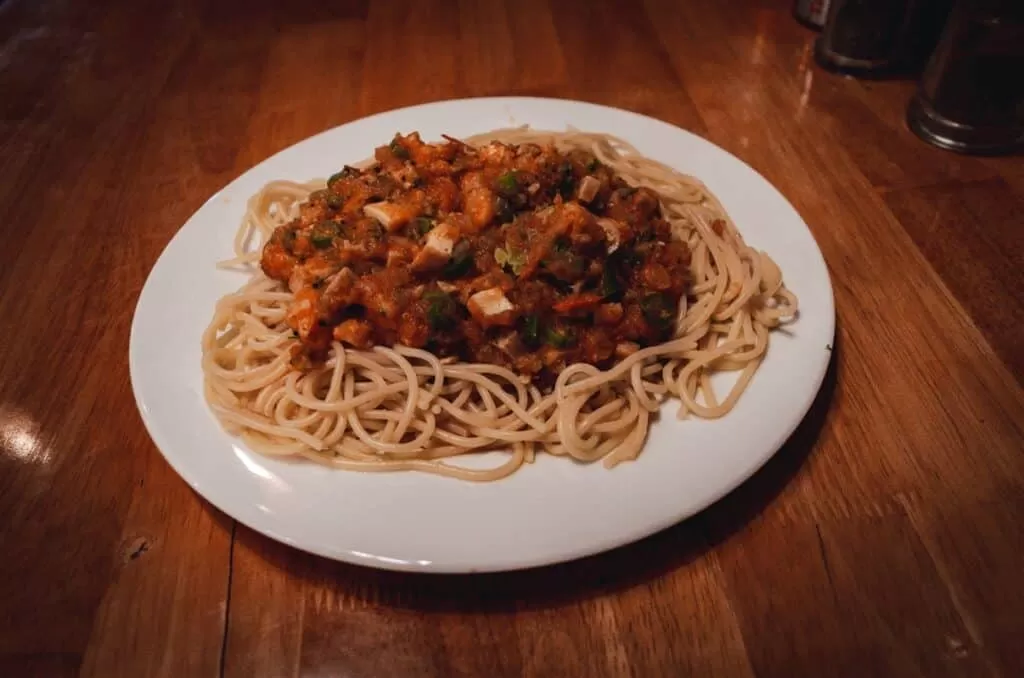
Pasta with tomato sauce and tofu
Pasta with tomato sauce is widely available in Thailand. You can find in restaurants geared toward Western tourists but also in Thai restaurants in smaller places.
Vegan burgers are also widely available in touristy areas in Thailand. The patties are mostly made of vegetables or can be slices of fried tofu.
Here are the websites I personally use whenever I travel to Thailand:
Booking.com: For the best guesthouses, homestays, or small hotels
Hostelworld: To find the best hostels located in the cities
Homestay: For a unique immersive homestay experience in the big cities or the countryside
12GO and Bookaway: The best transport websites for long-distance buses and train travel in Thailand
Thai Railway: To check timetables and connections for trains
Grab: The Uber of Southeast Asia is a convenient and cheap ride-hailing app
Skyscanner: For affordable flights to Bangkok or Phuket
Viator and Get Your Guide: book all kinds of activities from a vegan cooking class in Bangkok to a half-day meditation retreat at a waterfall temple with a monk.
Thailand is very easy to enter because you can stay in the country for up to 45 days with a tourist visa on arrival. If you want to spend more time in Thailand, check out the official Thai e-Visa website.
If you’re looking for travel insurance, the one with the best benefits online is without a doubt Heymondo! It’s very easy to ask for a quote on the website and if you book with this link you’ll get 5% off!
Get access to mobile data straight away when entering the country with a Thai E-sim or an Asialink E-sim when traveling through multiple countries. If you are already in Thailand, the best local prepaid sim card is AIS.
If you want to find vegan food in Thailand easily without the hassle of trying to explain yourself if little English is spoken then the cities, towns and islands below are good places to start.
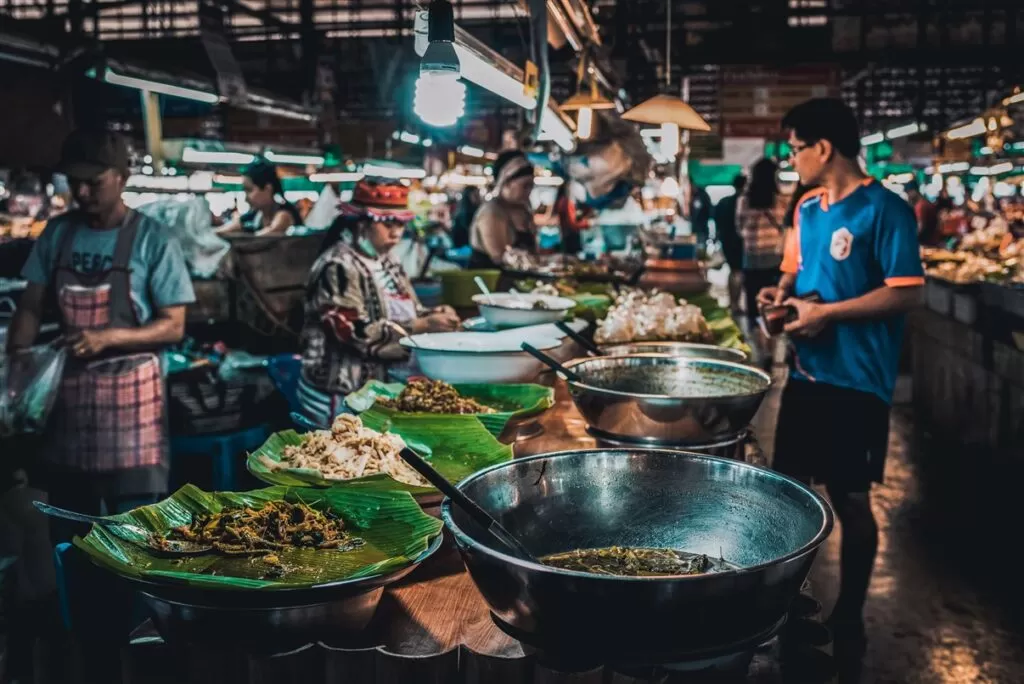
Morning Market in Chiang Mai
Chiang Mai is often called the vegan capital of Asia and with good reason. In Chiang Mai, you can find a variety of vegan food. This includes local food at Buddhist buffet restaurants but also trendy vegan restaurants like Goodsouls Kitchen and Free Bird Café.
Chiang Mai is the best place to start if you want to discover the vegan food scene in Thailand.
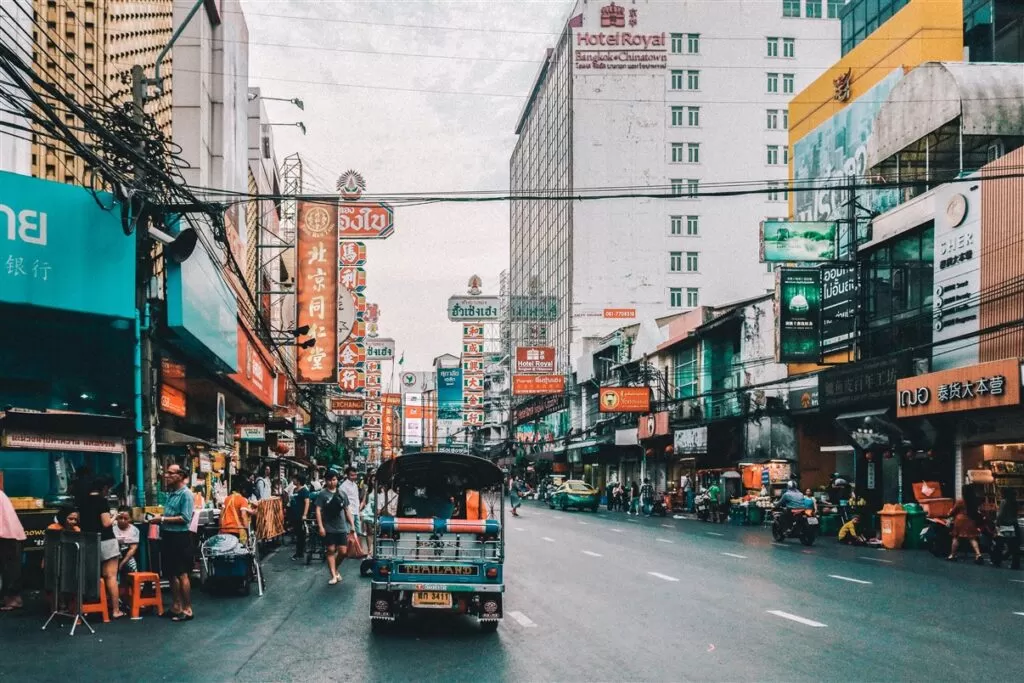
The streets of Bangkok
In Bangkok, you won’t have any trouble eating out as a vegan. The streets are filled with delicious food stalls selling vegan fare and hip restaurants like Veganerie and Broccoli Revolution.
If you plan to stay in Bangkok long-term and want to cook for yourself, you can find vegan meat substitutes at Siam Paragon’s Gourmet Market and vegan cheese at Barefoot Bangkok.
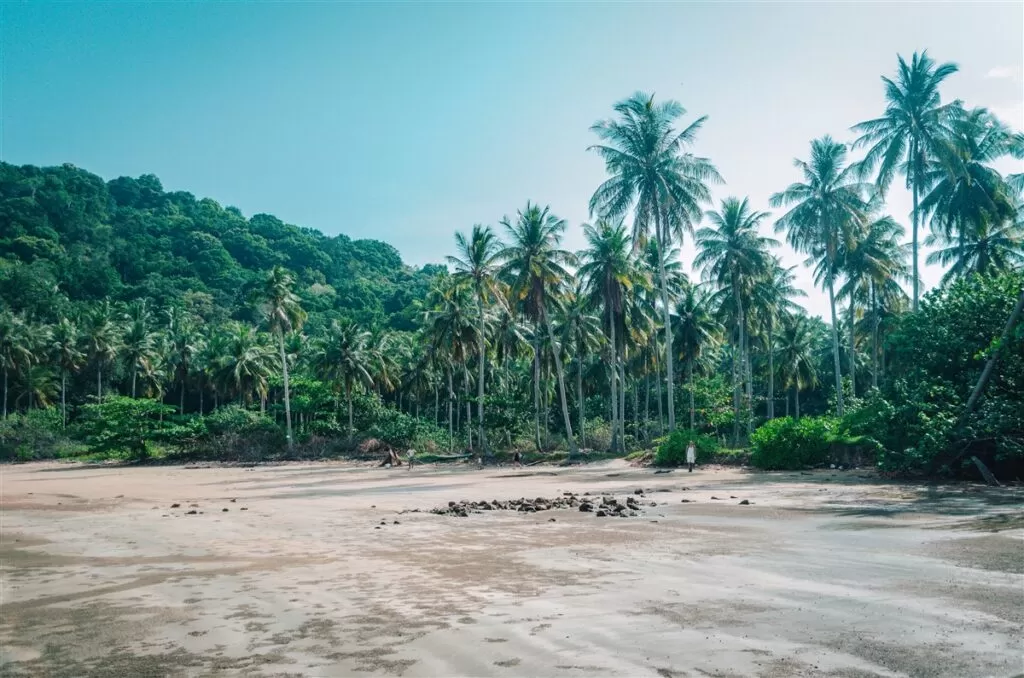
Coconut beach, Koh Pu.
All the popular islands in Thailand cater to vegans. You can find plenty of vegan choices at touristy islands like Koh Phangan, Koh Tao, and Koh Samui but also at lesser-known islands like Koh Phayam and Koh Jum.
The best way to check out the restaurants on these islands that cater to vegans is by visiting the website of Happycow.
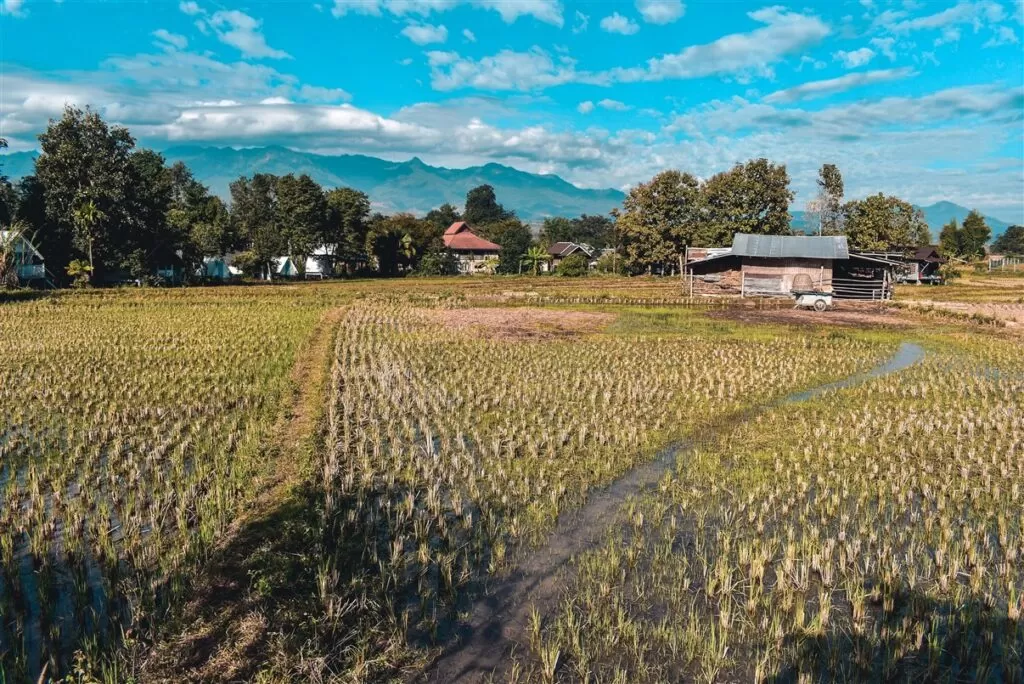
Pai, Thailand.
Pai is a small village in the north of Thailand that has gained immense popularity in recent years among travelers and ex-pats. As a result and due to popular demand, the vegan food scene has also boomed in Pai.
you can find a few food stalls selling wraps, falafel, and samosas that are fully vegan but also a range of vegetarian cafés that cater to vegans.
That said, it is in general very easy to find vegan fare everywhere in Thailand but you will need to explain your food preferences. The cities and places mentioned above are good if you want to find vegan food easily and if you don’t mind staying in touristy areas.
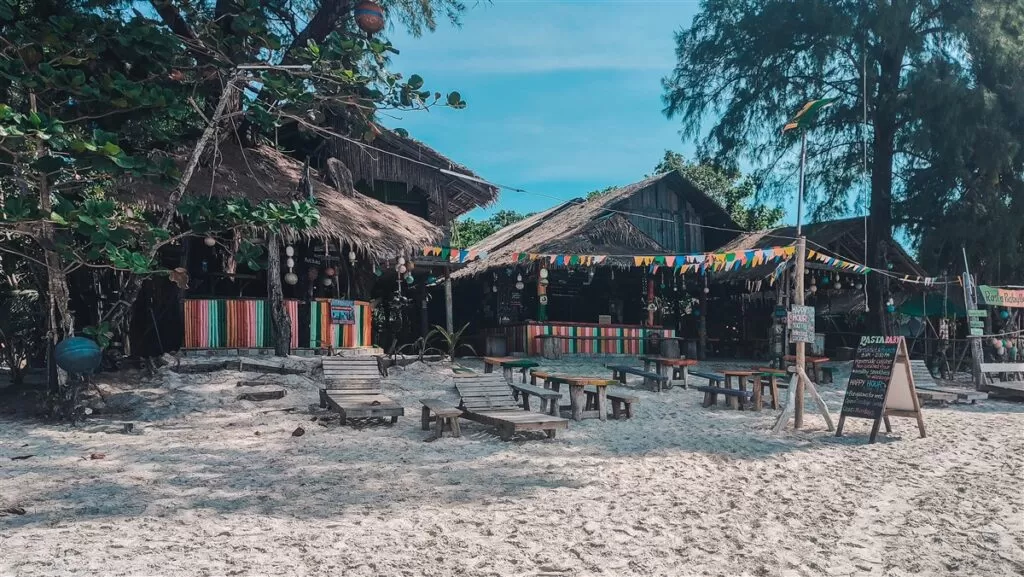
Beach restaurants, Koh Phayam.
There are many good restaurants out there in Thailand so this list is only the tip of the iceberg. Also, note that I don’t like to travel to places that are too busy and are filled with tourists so I can’t say what restaurants on Koh Phangan or Koh Samui are like.
Chiang Mai:
Pai:
Bangkok:
Koh Phayam:
The Thai Vegetarian Festival is a yearly 9-day festival that is celebrated all over Thailand. Locally known as the Jae Festival, during this time you can find many food stalls serving “Jae” food all over the country but especially in places like Chiang Mai, Bangkok, and Phuket.
If you travel to Thailand in October look out for yellow flags at restaurants windows and food stalls. This means the food they are preparing is “Jae”. Jae food is even more strict than vegan food since it also exclude things like onion and garlic.
There are a few vegan resorts and hotels that are 100% vegan or that cater to vegans. I will list a few great options below:
I have tried to find vegan food tours in Thailand but these are pretty hard to find. However, I did find some cooking schools that cater to vegans in Bangkok, Chiang Mai, Phuket, Koh Samui and Koh Lanta!
To finish this article, here are some useful Facebook groups that can help you navigate your vegan journey in Thailand even more:

Andaman beach, Koh Jum.
There you go! I hope you enjoyed this vegan in Thailand travel guide. As you can see, it’s not hard to travel in Thailand as a vegan if you know what dishes are suitable and which hidden ingredients to look out for.
if you have any questions, please let them know in the comments below or drop me a message through my contact page.
If, aside from vegan travel, you are also into sustainability, check out my favorite conscious travel gear!
ENJOY!
Disclaimer: This post may include affiliate links. If you click on them, I may receive a commission at no extra cost to you.
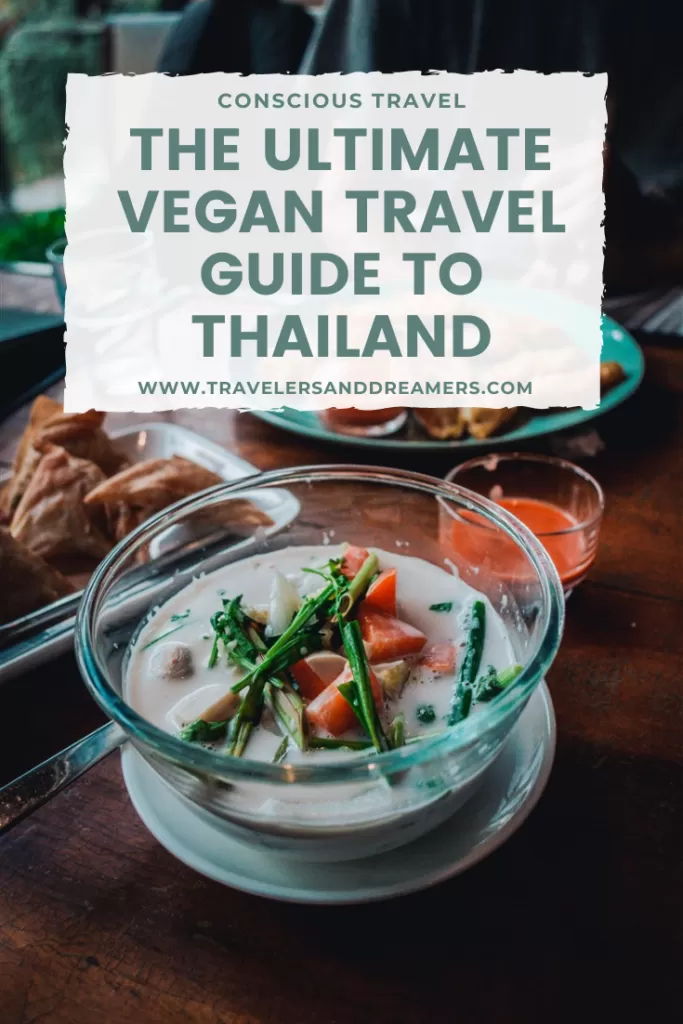
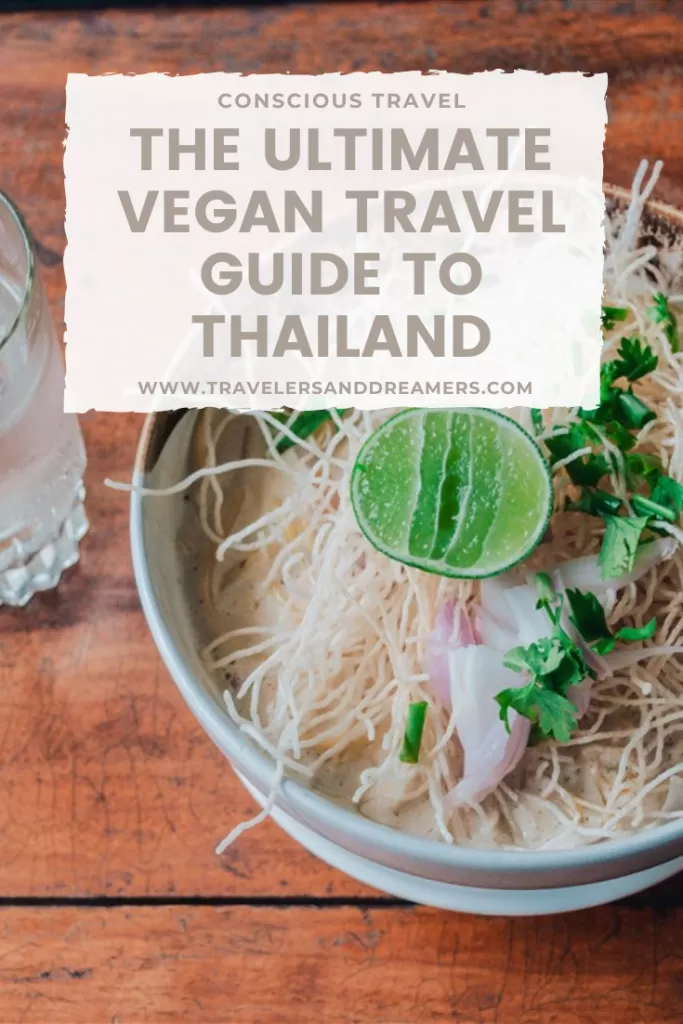

Hi! I am Annelies and this is Travelers & Dreamers, a blog about conscious travel which means traveling in a more mindful way, with a positive impact on the world and yourself!
On this website, I cover different topics like slow travel, plant-based food guides, responsible travel, sustainable packing, eco-travel, and more!
Latest Posts

Santa Rita, Salento: All You Need to Know
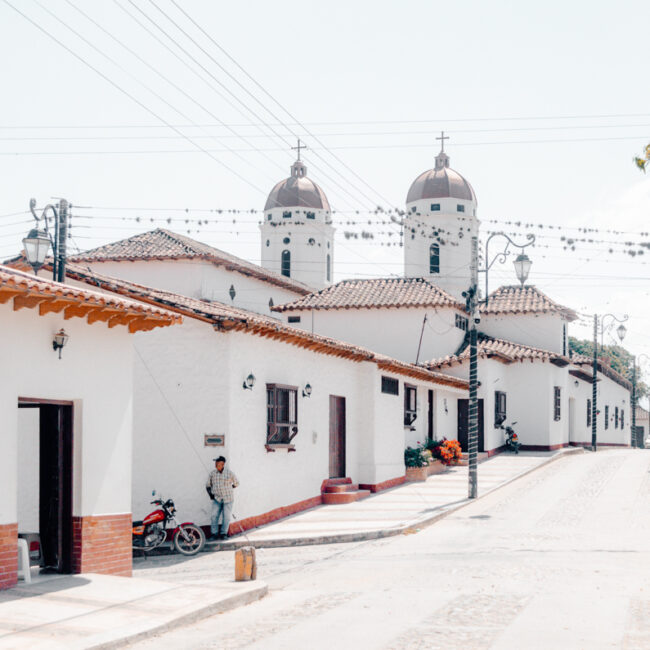
La Playa de Belen, Colombia: An Easy Travel guide!
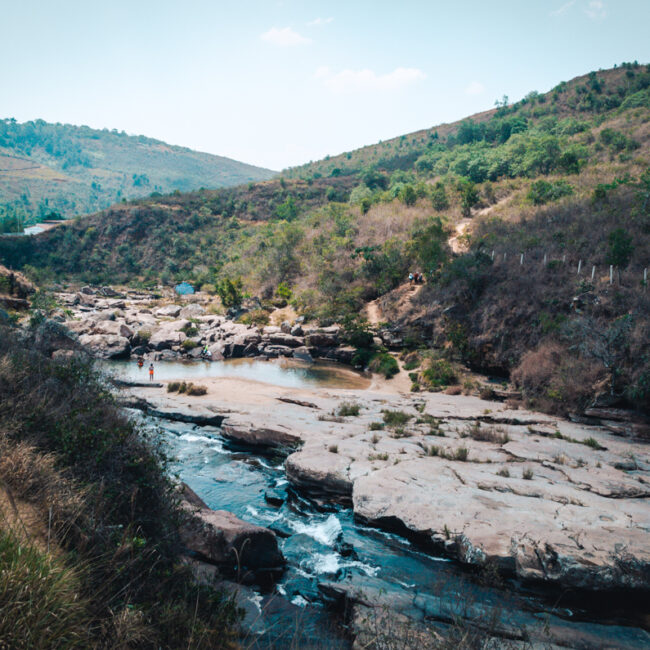
How to Visit the Pescaderito in Curiti (Near San Gil)

Los Estoraques Unique Natural Area: An Easy Travel Guide
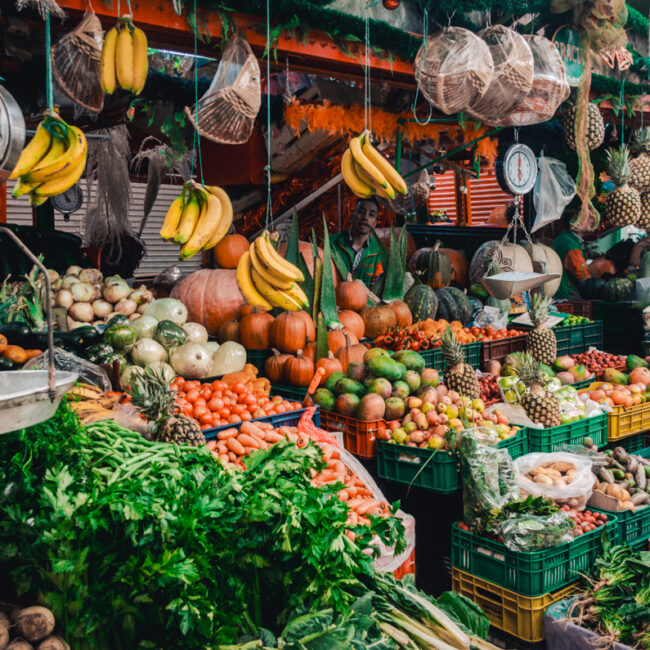
An Easy Guide to Paloquemao Fruit Market in Bogota
Do you want to receive my latest finds on conscious and sustainable travel directly to your inbox? Subscribe here!
© COPYRIGHT TRAVELERS&DREAMERS, 2023.